Paul Bishop's Blog, page 31
November 2, 2016
THE ACCOUNTANT
 THE ACCOUNTANT
THE ACCOUNTANTThe Accountant is a great men's adventure movie. Very underrated. Tight script with some excellent reveals. Affleck is outstanding. I enjoyed the new Jack Reacher film, but The Accountant is far superior—a homerun compared to a solid double. An action film with a deliberate build, requiring thinking, a bit of patience, and a trust all will come perfectly together in the end. My favorite movie of the year behind Hell Or High Water...
Published on November 02, 2016 23:30
October 6, 2016
PULP NOW: THE RETURN OF BLACK MASK
 PULP NOW: THE RETURN OF BLACK MASK COMING SOON
PULP NOW: THE RETURN OF BLACK MASK COMING SOONAltus Press has announced the return of the icon Black Mask magazine--renowned for the high level of quality fiction which they published for decades, including the early works of Raymond Chandler, Dashiel Hammett, Max Brand, John D. MacDonald, Erle Stanley Gardner, and so many others...I can't begin to explain what it means to have my name on the cover and the lead story in the first new issue of a magazine I have revered since I started putting words on paper...I'll post again when the issue is available...
Published on October 06, 2016 09:03
PUULP NOW: THE RETURN OF BLACK MASK
 PULP NOW: THE RETURN OF BLACK MASK COMING SOON
PULP NOW: THE RETURN OF BLACK MASK COMING SOONAltus Press has announced the return of the icon Black Mask magazine--renowned for the high level of quality fiction which they published for decades, including the early works of Raymond Chandler, Dashiel Hammett, Max Brand, John D. MacDonald, Erle Stanley Gardner, and so many others...I can't begin to explain what it means to have my name on the cover and the lead story in the first new issue of a magazine I have revered since I started putting words on paper...I'll post again when the issue is available...
Published on October 06, 2016 09:03
October 4, 2016
GUNSHINE STATE ~THE HEIST ALWAYS GOES WRONG
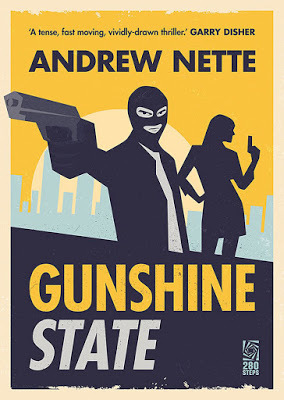 GUNSHINE STATE ~THE HEIST ALWAYS GOES WRONG I have enjoyed
PULP CURRY
—the spicy, noir-centric blog administered by Australia’s
ANDREW NETTE
—for many years. I also thoroughly enjoyed Andrew’s first novel
GHOST MONEY
when it was published in 2012.
GUNSHINE STATE ~THE HEIST ALWAYS GOES WRONG I have enjoyed
PULP CURRY
—the spicy, noir-centric blog administered by Australia’s
ANDREW NETTE
—for many years. I also thoroughly enjoyed Andrew’s first novel
GHOST MONEY
when it was published in 2012.
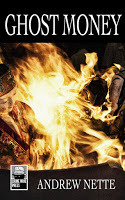 Set in the mid-nineties, Ghost Money was unusual and intriguing, following Australian ex-cop Max Quinlan as he searches for a missing businessman amidst the chaos of the long-running Khmer Rouge insurgency in Cambodia. Ghost Money was more than a crime novel, it also engaged me intellectually through its stark examination of a broken country and those individuals trapped between two periods of history, the choices they make, what they do to survive. Recently, Andrew’s heist thriller set in Queensland, Thailand and Melbourne—
GUNSHINE STATE
—was published by upstart crime publisher
280 STEPS
. Since Andrew’s knowledge of and fascination with heist thrillers and films is more than a match for my own, I was excited to dig into this intricate caper and it’s ensuing complications. Complications? Absolutely. Because the immutable truth of every heist thriller and caper film proves the heist always goes wrong...
Set in the mid-nineties, Ghost Money was unusual and intriguing, following Australian ex-cop Max Quinlan as he searches for a missing businessman amidst the chaos of the long-running Khmer Rouge insurgency in Cambodia. Ghost Money was more than a crime novel, it also engaged me intellectually through its stark examination of a broken country and those individuals trapped between two periods of history, the choices they make, what they do to survive. Recently, Andrew’s heist thriller set in Queensland, Thailand and Melbourne—
GUNSHINE STATE
—was published by upstart crime publisher
280 STEPS
. Since Andrew’s knowledge of and fascination with heist thrillers and films is more than a match for my own, I was excited to dig into this intricate caper and it’s ensuing complications. Complications? Absolutely. Because the immutable truth of every heist thriller and caper film proves the heist always goes wrong...
 I’m not sure if Andrew originally coined the catchphrase, the heist always goes wrong, but he has certainly turned it into a touchstone on his blog and made it a mainstay of his social networking outlets. From Richard Stark’s Parker novels to Max Allan Collin’s Nolan tales to Garry Disher’s Wyattcapers...the heist always goes wrong. From Rififi to Topkapi to The Seven Golden Men to The Italian Job to The Caper of the Golden Bulls to The Thomas Crown Affair...the heist always goes wrong. Heist novels, caper movies, even real life crimes, hinge on the unravelling complications when the heist always goes wrong... I had the opportunity to grill Andrew about Gunshine State and his love for the heist genre... Tell us a bit about Andrew Nette, Pulp Curry, and (for those not in on the pun) the title Gunshine State… I am a Melbourne-based writer of fiction and non-fiction. I have published two novels, of which Gunshine State is the latest, a swag of short stories and am currently co-editing a couple of books on the history of pulp fiction, the first of which looks at how various youth sub-cultures have been depicted in pulp fiction in the US, UK and Australia, 1950-1980. Pulp Curry is what I believe is called in the trade my online authorial real estate. It is my site where I write about crime fiction and film, pulp and popular (and not so popular) culture. The main character in Gunshine State, Gary Chance, is a former Australian army driver, ex-bouncer and thief. His latest job takes place in Surfers Paradise, working as part gang run by an aging stand over man, Dennis Curry, who runs off-site, non-casino poker games, and wants to rob one of his best customers, a high roller called Frederick Freddie Gao. The job seems straightforward, but Curry's crew is anything but. Chance knows he can't trust anyone, but nothing prepares him for what unfolds when Curry's plan goes wrong. If you look it up on the Internet, you’ll see the term Gunshine State has been used to refer to the US state of Florida. I only discovered this after I had decided use it as the title for my novel. I first stumbled across the term in a tabloid headline I read years ago about gun trafficking in Queensland. Whatever the case, I think you get the drift of what it means, somewhere sunny with a lot of crime and dark deeds. How and when did your fascination with heists in novels and films start? Watching crime films with my late father. My love of a lot of good things, jazz music, vintage pulp novels and movies, can be traced back to things I was exposed to in my youth though my father. If you had to pick one heist film and one caper film as your favorite what would they be?
I’m not sure if Andrew originally coined the catchphrase, the heist always goes wrong, but he has certainly turned it into a touchstone on his blog and made it a mainstay of his social networking outlets. From Richard Stark’s Parker novels to Max Allan Collin’s Nolan tales to Garry Disher’s Wyattcapers...the heist always goes wrong. From Rififi to Topkapi to The Seven Golden Men to The Italian Job to The Caper of the Golden Bulls to The Thomas Crown Affair...the heist always goes wrong. Heist novels, caper movies, even real life crimes, hinge on the unravelling complications when the heist always goes wrong... I had the opportunity to grill Andrew about Gunshine State and his love for the heist genre... Tell us a bit about Andrew Nette, Pulp Curry, and (for those not in on the pun) the title Gunshine State… I am a Melbourne-based writer of fiction and non-fiction. I have published two novels, of which Gunshine State is the latest, a swag of short stories and am currently co-editing a couple of books on the history of pulp fiction, the first of which looks at how various youth sub-cultures have been depicted in pulp fiction in the US, UK and Australia, 1950-1980. Pulp Curry is what I believe is called in the trade my online authorial real estate. It is my site where I write about crime fiction and film, pulp and popular (and not so popular) culture. The main character in Gunshine State, Gary Chance, is a former Australian army driver, ex-bouncer and thief. His latest job takes place in Surfers Paradise, working as part gang run by an aging stand over man, Dennis Curry, who runs off-site, non-casino poker games, and wants to rob one of his best customers, a high roller called Frederick Freddie Gao. The job seems straightforward, but Curry's crew is anything but. Chance knows he can't trust anyone, but nothing prepares him for what unfolds when Curry's plan goes wrong. If you look it up on the Internet, you’ll see the term Gunshine State has been used to refer to the US state of Florida. I only discovered this after I had decided use it as the title for my novel. I first stumbled across the term in a tabloid headline I read years ago about gun trafficking in Queensland. Whatever the case, I think you get the drift of what it means, somewhere sunny with a lot of crime and dark deeds. How and when did your fascination with heists in novels and films start? Watching crime films with my late father. My love of a lot of good things, jazz music, vintage pulp novels and movies, can be traced back to things I was exposed to in my youth though my father. If you had to pick one heist film and one caper film as your favorite what would they be?
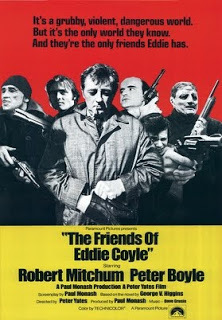 That’s a tough one. If I had to pick a favourite heist film it would probably be The Friends of Eddie Coyle (1973), although John Huston’s 1950 classic, would come close. Robert Mitchum is fantastic as Eddie Fingers Coyle, a 51 year-old ex-con, gunrunner and who knows what else in his criminal career, facing the prospect of a three to five year jail stretch for being caught driving a truckload of stolen whisky. Coyle will do anything to stay out prison, but all he’s got to trade is information, in particular, information on the identity of the gang that has been pulling off a series of audacious bank robberies. Supporting Mitchum is a wonderful group of character actors, including Stephen Keats, Richard Jordan and Peter Boyle. The story, look, the dialogue, every aspect of this film works superbly.
That’s a tough one. If I had to pick a favourite heist film it would probably be The Friends of Eddie Coyle (1973), although John Huston’s 1950 classic, would come close. Robert Mitchum is fantastic as Eddie Fingers Coyle, a 51 year-old ex-con, gunrunner and who knows what else in his criminal career, facing the prospect of a three to five year jail stretch for being caught driving a truckload of stolen whisky. Coyle will do anything to stay out prison, but all he’s got to trade is information, in particular, information on the identity of the gang that has been pulling off a series of audacious bank robberies. Supporting Mitchum is a wonderful group of character actors, including Stephen Keats, Richard Jordan and Peter Boyle. The story, look, the dialogue, every aspect of this film works superbly.
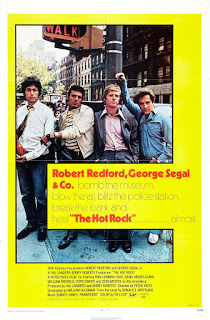 I consider caperfilms a softer, often more humorous variation on the heist movie (plus, in a caper film, the criminals usually get away with it). If I had to nominate a favourite it would be another Peter Yates film, The Hot Rock, released in 1972. Based on novel by Donald Westlake (whose writing I love), the story revolves around a thief called Dortmunder (Robert Redford), approached by the ambassador of an African state (Mosus Gunn) to steal a valuable gem from a New York museum. This film has a terrific cast (in addition to Redford and Gunn, there is Ron Leiberman and Charlotte Rae), a cracking Quincy Jones soundtrack, and a plot with great twists and turns. From where did you get the inspiration for Gunshine State? Gunshine State is my attempt to do a quintessential Australian take on heist crime fiction. I also wanted to try and do justice to the shady past of what was once Australia’s premier holiday destination, the faux Miami known as Surfers Paradise, in Queensland, where a chunk of the book is set. Does your main character—former Australian army driver, ex-bouncer and thief, Gary Chance—have a real life counterpart, or is he completely a spark of your own imagination? He has no real life counterpart I am aware of, although, I did talk to a couple of ex-Australian army guys to get a sense of what Chance might be like, and his experiences in East Timor and Afghanistan, where he drove trucks. My point was, I wanted an ex-army character who did something relatively routine in the Australian army, if you get what I mean. I didn’t want the character to be ex-SAS or some sort of super soldier. Did you feel confined by the tropes of the heist genre or was there a way to get outside of them? The only stipulation of the heist genre I wanted to abide by is that the story’s initial heist had to go wrong, resulting in very bad things happening to my main characters. Otherwise, I tried to mix the plot up as much as possible. Only the reader can tell me whether I have been successful or not. Do you see Australian crime fiction gaining a higher international profile? Let’s hope so. I think there is some great crime fiction being published at the moment (some of which I have written about on my site) and it would be great to see it get a wider audience. Will there be a follow up to Gunshine State, and will the heist go wrong? There will definitely be a follow up. I have the plot. Now I just need to find the time to write it. And yes, the planned heist did go wrong…about forty years ago. Thx, Andrew...I appreciate chatting with you and hope Gary Chance manages to keep capering and stay out of prison for the foreseeable future...
I consider caperfilms a softer, often more humorous variation on the heist movie (plus, in a caper film, the criminals usually get away with it). If I had to nominate a favourite it would be another Peter Yates film, The Hot Rock, released in 1972. Based on novel by Donald Westlake (whose writing I love), the story revolves around a thief called Dortmunder (Robert Redford), approached by the ambassador of an African state (Mosus Gunn) to steal a valuable gem from a New York museum. This film has a terrific cast (in addition to Redford and Gunn, there is Ron Leiberman and Charlotte Rae), a cracking Quincy Jones soundtrack, and a plot with great twists and turns. From where did you get the inspiration for Gunshine State? Gunshine State is my attempt to do a quintessential Australian take on heist crime fiction. I also wanted to try and do justice to the shady past of what was once Australia’s premier holiday destination, the faux Miami known as Surfers Paradise, in Queensland, where a chunk of the book is set. Does your main character—former Australian army driver, ex-bouncer and thief, Gary Chance—have a real life counterpart, or is he completely a spark of your own imagination? He has no real life counterpart I am aware of, although, I did talk to a couple of ex-Australian army guys to get a sense of what Chance might be like, and his experiences in East Timor and Afghanistan, where he drove trucks. My point was, I wanted an ex-army character who did something relatively routine in the Australian army, if you get what I mean. I didn’t want the character to be ex-SAS or some sort of super soldier. Did you feel confined by the tropes of the heist genre or was there a way to get outside of them? The only stipulation of the heist genre I wanted to abide by is that the story’s initial heist had to go wrong, resulting in very bad things happening to my main characters. Otherwise, I tried to mix the plot up as much as possible. Only the reader can tell me whether I have been successful or not. Do you see Australian crime fiction gaining a higher international profile? Let’s hope so. I think there is some great crime fiction being published at the moment (some of which I have written about on my site) and it would be great to see it get a wider audience. Will there be a follow up to Gunshine State, and will the heist go wrong? There will definitely be a follow up. I have the plot. Now I just need to find the time to write it. And yes, the planned heist did go wrong…about forty years ago. Thx, Andrew...I appreciate chatting with you and hope Gary Chance manages to keep capering and stay out of prison for the foreseeable future...
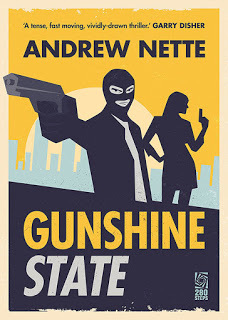 GUNSHINE STATE A heist thriller set in Queensland, Melbourne and Thailand. Think Richard Stark’s Parker, Garry Disher’s Wyatt, and Wallace Stroby's Crissa Stone. Add a touch of Surfers Paradise sleaze and a very dangerous stopover in Asia. Gary Chance is a former Australian army driver, ex-bouncer and thief. His latest job takes him to Surfers Paradise, Queensland, working for aging standover man, Dennis Curry. Curry runs off-site, non-casino poker games, and wants to rob one of his best customers, a high roller called Freddie Gao. The job seems straightforward but Curry's crew is anything but. Frank Dormer is a secretive ex-soldier turned private security contractor. Sophia Lekakis is a highly-strung receptionist at the hotel where Gao stays when he visits Surfers Paradise. Amber, Curry's female housemate, is part of the lure for Gao. Chance knows he can't trust anyone, but nothing prepares him for what unfolds when Curry's plan goes wrong...
PULP CURRY: TEN BEST HEIST FILMS EVER MADE
PULP CURRY: READERS’ FAVORITE HEIST FILMS
PULP CURRY TEN BEST HEIST FILMS YOU’VE NEVER SEEN
GUNSHINE STATE A heist thriller set in Queensland, Melbourne and Thailand. Think Richard Stark’s Parker, Garry Disher’s Wyatt, and Wallace Stroby's Crissa Stone. Add a touch of Surfers Paradise sleaze and a very dangerous stopover in Asia. Gary Chance is a former Australian army driver, ex-bouncer and thief. His latest job takes him to Surfers Paradise, Queensland, working for aging standover man, Dennis Curry. Curry runs off-site, non-casino poker games, and wants to rob one of his best customers, a high roller called Freddie Gao. The job seems straightforward but Curry's crew is anything but. Frank Dormer is a secretive ex-soldier turned private security contractor. Sophia Lekakis is a highly-strung receptionist at the hotel where Gao stays when he visits Surfers Paradise. Amber, Curry's female housemate, is part of the lure for Gao. Chance knows he can't trust anyone, but nothing prepares him for what unfolds when Curry's plan goes wrong...
PULP CURRY: TEN BEST HEIST FILMS EVER MADE
PULP CURRY: READERS’ FAVORITE HEIST FILMS
PULP CURRY TEN BEST HEIST FILMS YOU’VE NEVER SEEN
Published on October 04, 2016 10:35
October 1, 2016
WILDCAT OF THE WEST
 WILDCAT OF THE WEST
WILDCAT OF THE WEST
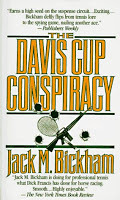 In 1989, I discovered the first book in a cool series of tennis thrillers featuring international tennis star and sometimes-CIA assistant, Brad Smith. The books were published by Tor, who was also published my first three novels. I never knew the author of the series, Jack Bickham, but I enjoyed each adventure in the six book series as it hit the bookshelves.
In 1989, I discovered the first book in a cool series of tennis thrillers featuring international tennis star and sometimes-CIA assistant, Brad Smith. The books were published by Tor, who was also published my first three novels. I never knew the author of the series, Jack Bickham, but I enjoyed each adventure in the six book series as it hit the bookshelves.
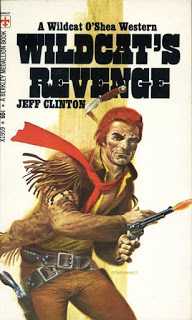 Only recently, however, I discovered Jack Bickham’s earliest novels were western paperback originals published under various pseudonyms. Without a doubt the most original of these efforts were the fifteen novels Bickham wrote under the pseudonym Jeff Clinton featuring Wildcat O’Shea—the flightiness, drunkest, hardest-headed, most colorful, largest galoot to ever hit the trail. Wildcat is certainly not your standard western hero, but you’d definitely want him as a friend, especially in the middle of a bar fight.
Only recently, however, I discovered Jack Bickham’s earliest novels were western paperback originals published under various pseudonyms. Without a doubt the most original of these efforts were the fifteen novels Bickham wrote under the pseudonym Jeff Clinton featuring Wildcat O’Shea—the flightiness, drunkest, hardest-headed, most colorful, largest galoot to ever hit the trail. Wildcat is certainly not your standard western hero, but you’d definitely want him as a friend, especially in the middle of a bar fight.
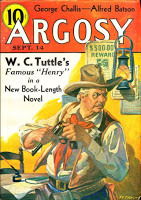 There have been other humorous western characters, most notably Hashknife Hartley and his partner Sleepy Stevens created by W. C. Tuttle during the ‘30s for the then uber-popular western pulps (http://tinyurl.com/ht5ffnj). Tuttle also created the pulp character Henry Harrison Conroy, a down-at-the-heels vaudeville comedian reluctantly turned Arizona sheriff (http://tinyurl.com/jkce5ky). In both of these series, Tuttle deftly merged the western and detective genres holding them together with humor as the glue.
There have been other humorous western characters, most notably Hashknife Hartley and his partner Sleepy Stevens created by W. C. Tuttle during the ‘30s for the then uber-popular western pulps (http://tinyurl.com/ht5ffnj). Tuttle also created the pulp character Henry Harrison Conroy, a down-at-the-heels vaudeville comedian reluctantly turned Arizona sheriff (http://tinyurl.com/jkce5ky). In both of these series, Tuttle deftly merged the western and detective genres holding them together with humor as the glue.
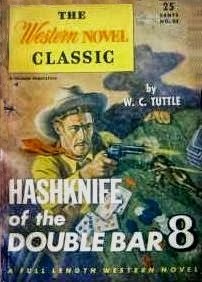 Like these predecessors, Wildcat appears to be a little slow on the uptake, but nothing much actually misses his notice. His penchant for drinking and fighting is often at odds with his common sense, but when trouble breaks out he hits harder than anyone around. Wildcat also has heart, he is an amiable companion, and you just can’t help liking him or laughing at the predicaments he gets himself into. Make no mistake, though, there is enough gunsmoke and action to keep traditional western fans onboard.
Like these predecessors, Wildcat appears to be a little slow on the uptake, but nothing much actually misses his notice. His penchant for drinking and fighting is often at odds with his common sense, but when trouble breaks out he hits harder than anyone around. Wildcat also has heart, he is an amiable companion, and you just can’t help liking him or laughing at the predicaments he gets himself into. Make no mistake, though, there is enough gunsmoke and action to keep traditional western fans onboard.
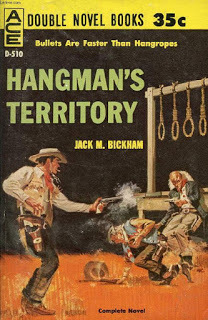 On his fact filled website (http://www.benbridges.co.uk), prolific bestselling western writer, Ben Bridges states Wildcat was first introduced in an earlier western by Bickham, Hangman's Territory, under the name Boom-Boom O'Malley. However, while this name didn’t stick, Bickham liked the character so much he began a new series in which the character’s new handle was Wildcat O'Shea. Bickham stated, Until Boom-Boom came along, I didn't know I could write humour. I enjoyed writing about the guy...The moment I wrote that first half-drunken scene with him, my imagination lit up from the exaggeration and I thought I had someone special.
On his fact filled website (http://www.benbridges.co.uk), prolific bestselling western writer, Ben Bridges states Wildcat was first introduced in an earlier western by Bickham, Hangman's Territory, under the name Boom-Boom O'Malley. However, while this name didn’t stick, Bickham liked the character so much he began a new series in which the character’s new handle was Wildcat O'Shea. Bickham stated, Until Boom-Boom came along, I didn't know I could write humour. I enjoyed writing about the guy...The moment I wrote that first half-drunken scene with him, my imagination lit up from the exaggeration and I thought I had someone special.
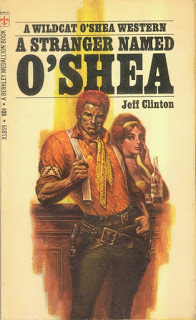 In The Fighting Buckaroo, Wildcat also shows off his sense of sartorial splendor—Wildcat felt a flush of pride. He had worn his best, by jingo, and he was making an impression! Oh, they’d sit up and take notice, all right, when a man with some real fine clothes and gear rode in. Wildcat had painted his saddle flaming orange, and his boots green and yellow. He wore a new blue hat, wide brimmed, a red shirt and deep blue Levis, a black vest and fancy Mexican spurs with purple rowles. He hadn’t messed with his Colt revolver, or finely oiled holster, or with the Winchester in his saddle boot. With these the action and not the looks was what counted…Yes, Wildcat makes quit an entrance. The Wildcat adventure are a hoot and filled with action. They have become some of my favorite western tales... WILDCAT O’SHEA SERIES The Fighting Buckaroo (1961)Wildcat's Rampage (1962)Wildcat Against the House (1963)Wildcat's Revenge (1964)*Wanted: Wildcat O'Shea (1966)Wildcat Takes His Medicine (1966)Wildcat On The Loose (1967)Wildcat's Witch Hunt (1967)Watchout For Wildcat (1968)Wildcat Meets Miss Melody (1968) Build a Box for Wildcat (1969)A Stranger Named O'Shea (1970)* Bounty On Wildcat (1971)* Wildcat's Claim To Fame (1971)* Hang High O'Shea (1972) *Four of the fifteen Wildcat novels sported cover illustrations by James Bama (best known for his Doc Savage covers and much more) making them highly collectible. *Wildcat’s first appearance was as Boom-Boom O'Malley in Hangman's Territory, which Bickham wrote under his own name.
In The Fighting Buckaroo, Wildcat also shows off his sense of sartorial splendor—Wildcat felt a flush of pride. He had worn his best, by jingo, and he was making an impression! Oh, they’d sit up and take notice, all right, when a man with some real fine clothes and gear rode in. Wildcat had painted his saddle flaming orange, and his boots green and yellow. He wore a new blue hat, wide brimmed, a red shirt and deep blue Levis, a black vest and fancy Mexican spurs with purple rowles. He hadn’t messed with his Colt revolver, or finely oiled holster, or with the Winchester in his saddle boot. With these the action and not the looks was what counted…Yes, Wildcat makes quit an entrance. The Wildcat adventure are a hoot and filled with action. They have become some of my favorite western tales... WILDCAT O’SHEA SERIES The Fighting Buckaroo (1961)Wildcat's Rampage (1962)Wildcat Against the House (1963)Wildcat's Revenge (1964)*Wanted: Wildcat O'Shea (1966)Wildcat Takes His Medicine (1966)Wildcat On The Loose (1967)Wildcat's Witch Hunt (1967)Watchout For Wildcat (1968)Wildcat Meets Miss Melody (1968) Build a Box for Wildcat (1969)A Stranger Named O'Shea (1970)* Bounty On Wildcat (1971)* Wildcat's Claim To Fame (1971)* Hang High O'Shea (1972) *Four of the fifteen Wildcat novels sported cover illustrations by James Bama (best known for his Doc Savage covers and much more) making them highly collectible. *Wildcat’s first appearance was as Boom-Boom O'Malley in Hangman's Territory, which Bickham wrote under his own name.
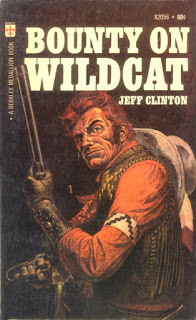
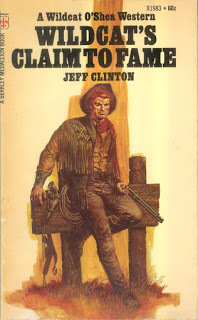
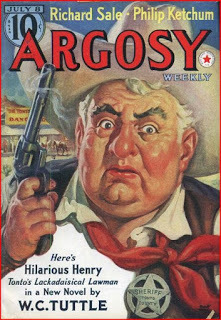
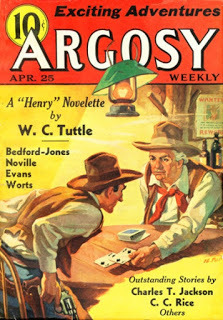
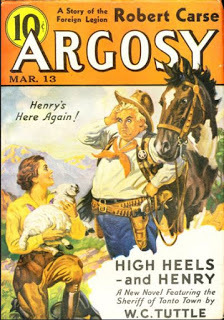
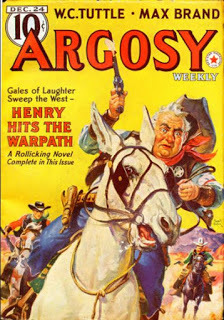
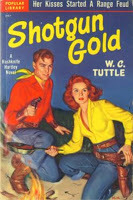
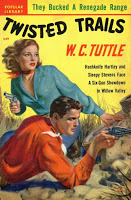
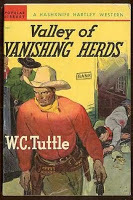
Published on October 01, 2016 17:44
September 30, 2016
ECLECTIC READING HIGHLIGHTS
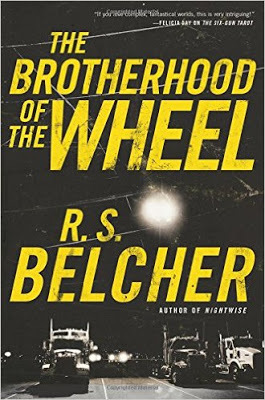 ECLECTIC READING HIGHLIGHTS My reading interests are wide and eclectic bordering on eccentric. I’m always scouting for current books with a cool new premise or a twist on an old theme. I also enjoy discovering older books by authors either new to me, or who I have never read in the past, but am now drawn to try. These forays aren’t always spectacular successes. Some are downright flops that don’t pass my twenty page test—if I’m not drawn into a story in twenty pages, it’s time to move on. I may miss a few gems, but I’d rather pick up another potential winner than wade through boring books to see if they get any better. Even if a book is mediocre, I no longer have the desire, the attention span, or the compulsion to finish it simply because I started it. This means I do a lot of separating wheat from chaff, but the end result is the joy of discovering worthwhile, enjoyable reading. Here’s a look at some recent titles I found worthwhile... THE BROTHERHOOD OF THE WHEEL ~ R. S. BELCHER
ECLECTIC READING HIGHLIGHTS My reading interests are wide and eclectic bordering on eccentric. I’m always scouting for current books with a cool new premise or a twist on an old theme. I also enjoy discovering older books by authors either new to me, or who I have never read in the past, but am now drawn to try. These forays aren’t always spectacular successes. Some are downright flops that don’t pass my twenty page test—if I’m not drawn into a story in twenty pages, it’s time to move on. I may miss a few gems, but I’d rather pick up another potential winner than wade through boring books to see if they get any better. Even if a book is mediocre, I no longer have the desire, the attention span, or the compulsion to finish it simply because I started it. This means I do a lot of separating wheat from chaff, but the end result is the joy of discovering worthwhile, enjoyable reading. Here’s a look at some recent titles I found worthwhile... THE BROTHERHOOD OF THE WHEEL ~ R. S. BELCHER
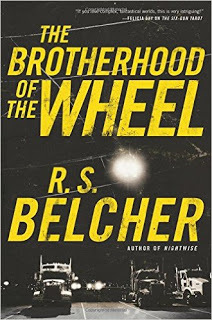 Belcher is a new author to me, but has been lauded for his previous horror/supernatural action titles Six Gun Tarot and Shotgun Arcana. He has now launched a gritty new urban fantasy series about the mysterious society of truckers known only as, The Brotherhood of The Wheel... In 1119 A.D., a group of nine crusaders became known as the Poor Fellow-Soldiers of Christ and of the Temple of Solomon--a militant monastic order charged with protecting pilgrims and caravans traveling on the roads to and from the Holy Land. In time, the Knights Templar would grow in power and, ultimately, be laid low. But a small offshoot of the Templars endure and have returned to the order's original mission: to defend the roads of the world and guard those who travel on them. Theirs is a secret line of knights: truckers, bikers, taxi hacks, state troopers, bus drivers, RV gypsies--any of the folks who live and work on the asphalt arteries of America. They call themselves the Brotherhood of the Wheel. Jimmy Aussapile is one such knight. He's driving a big rig down South when a promise to a ghostly hitchhiker sets him on a quest to find out the terrible truth behind a string of children gone missing all across the country. The road leads him to Lovina Hewitt, a skeptical Louisiana State Police investigator working the same case and, eventually, to a forgotten town that's not on any map--and to the secret behind the eerie Black-Eyed Kids said to prowl the highways. THE STRIVER’S ROW SPY ~ JASON OVERSTREET
Belcher is a new author to me, but has been lauded for his previous horror/supernatural action titles Six Gun Tarot and Shotgun Arcana. He has now launched a gritty new urban fantasy series about the mysterious society of truckers known only as, The Brotherhood of The Wheel... In 1119 A.D., a group of nine crusaders became known as the Poor Fellow-Soldiers of Christ and of the Temple of Solomon--a militant monastic order charged with protecting pilgrims and caravans traveling on the roads to and from the Holy Land. In time, the Knights Templar would grow in power and, ultimately, be laid low. But a small offshoot of the Templars endure and have returned to the order's original mission: to defend the roads of the world and guard those who travel on them. Theirs is a secret line of knights: truckers, bikers, taxi hacks, state troopers, bus drivers, RV gypsies--any of the folks who live and work on the asphalt arteries of America. They call themselves the Brotherhood of the Wheel. Jimmy Aussapile is one such knight. He's driving a big rig down South when a promise to a ghostly hitchhiker sets him on a quest to find out the terrible truth behind a string of children gone missing all across the country. The road leads him to Lovina Hewitt, a skeptical Louisiana State Police investigator working the same case and, eventually, to a forgotten town that's not on any map--and to the secret behind the eerie Black-Eyed Kids said to prowl the highways. THE STRIVER’S ROW SPY ~ JASON OVERSTREET
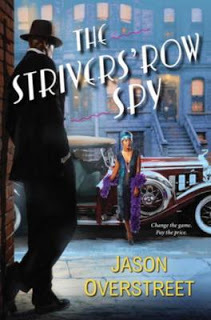 Set in 1920’s Harlem, this debut novel features the FBI’s first African-American agent, who has a very complicated personal agenda... Stunning, suspenseful, and unforgettably evocative...glitters with the vibrant dreams and dangerous promise of the 1920s Harlem Renaissance, as one man crosses the perilous lines between the law, loyalty, and deadly lies... For college graduate Sidney Temple, the Roaring Twenties bring opportunities even members of his accomplished black bourgeois family couldn’t have imagined. His impulsive marriage to independent artist Loretta is a happiness he never thought he’d find. And when he’s tapped by J. Edgar Hoover to be the FBI’s first African-American agent, he sees a once-in-a-lifetime chance to secure real justice... Instead of providing evidence against Marcus Garvey, prominent head of the ‘dangerously radical’ back-to-Africa movement, Sidney uses his unexpected knack for deception and undercover work to thwart the Bureau’s biased investigation. And by giving renowned leader W. E. B. Du Bois insider information, Sidney gambles on change that could mean a fair destiny for all Americans... But the higher Sidney and Loretta climb in Harlem’s most influential and glamorous circles, the more dangerous the stakes. An unexpected friendship and a wrenching personal tragedy threaten to shatter Loretta’s innocent trust in her husband—and turn his double life into a fast-closing trap. For Sidney, ultimately squeezed between the Bureau and one too many ruthless factions, the price of escape could be heartbreak and betrayal no amount of skill can help him survive. IRON GODDESS: A SHEA STEVENS THRILLER ~ DHARMA KELLEHER
Set in 1920’s Harlem, this debut novel features the FBI’s first African-American agent, who has a very complicated personal agenda... Stunning, suspenseful, and unforgettably evocative...glitters with the vibrant dreams and dangerous promise of the 1920s Harlem Renaissance, as one man crosses the perilous lines between the law, loyalty, and deadly lies... For college graduate Sidney Temple, the Roaring Twenties bring opportunities even members of his accomplished black bourgeois family couldn’t have imagined. His impulsive marriage to independent artist Loretta is a happiness he never thought he’d find. And when he’s tapped by J. Edgar Hoover to be the FBI’s first African-American agent, he sees a once-in-a-lifetime chance to secure real justice... Instead of providing evidence against Marcus Garvey, prominent head of the ‘dangerously radical’ back-to-Africa movement, Sidney uses his unexpected knack for deception and undercover work to thwart the Bureau’s biased investigation. And by giving renowned leader W. E. B. Du Bois insider information, Sidney gambles on change that could mean a fair destiny for all Americans... But the higher Sidney and Loretta climb in Harlem’s most influential and glamorous circles, the more dangerous the stakes. An unexpected friendship and a wrenching personal tragedy threaten to shatter Loretta’s innocent trust in her husband—and turn his double life into a fast-closing trap. For Sidney, ultimately squeezed between the Bureau and one too many ruthless factions, the price of escape could be heartbreak and betrayal no amount of skill can help him survive. IRON GODDESS: A SHEA STEVENS THRILLER ~ DHARMA KELLEHER
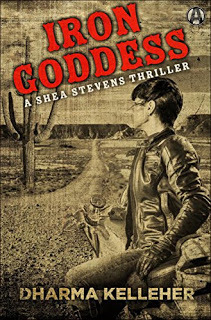 Who isn’t up for a kick-ass lesbian biker chick thriller? Sexual politics aside, this debut mash-up mixes Sons of Anarchy with The Girl with the Dragon Tattoo to produce an effective wild ride. I’ll definitely be looking for the follow-up... In this gritty, fast-paced debut thriller, an ex-con biker chick turned law-abiding citizen risks everything to save her new life—and confront the demons of her past. Shea Stevens is biker royalty. Her father was the president of the Confederate Thunder Motorcycle Club. Under his watchful eye, she learned how to pick locks, disable alarms, and hot-wire cars like a pro. But all that is ancient history. Or so she thought... After a stint in prison, Shea has worked hard to make a quiet, happy life for herself in Arizona. She spends her time bonding with her big-city girlfriend and running her bike shop, Iron Goddess Custom Cycles, with her dedicated team of misfits. But when one of her employees is shot and three of her specially commissioned bikes are stolen, Shea’s new life collides with the criminal underworld she tried to leave behind. Shea knows better than to trust the police. So, with her Glock on her hip, she takes the investigation into her own hands. Shea’s search for the bike thieves leads her straight to her father’s old gang—and her estranged sister, whose young daughter has been kidnapped by a rival club. The last thing Shea wants is to be caught in the middle of a war—but if she learned one thing from her old man, it’s that when someone comes at you, you push back. Hard. And that’s exactly what she’s going to do. THE TALL MAN IN THE RAY-BANS ~ JOSEPH FLYNN
Who isn’t up for a kick-ass lesbian biker chick thriller? Sexual politics aside, this debut mash-up mixes Sons of Anarchy with The Girl with the Dragon Tattoo to produce an effective wild ride. I’ll definitely be looking for the follow-up... In this gritty, fast-paced debut thriller, an ex-con biker chick turned law-abiding citizen risks everything to save her new life—and confront the demons of her past. Shea Stevens is biker royalty. Her father was the president of the Confederate Thunder Motorcycle Club. Under his watchful eye, she learned how to pick locks, disable alarms, and hot-wire cars like a pro. But all that is ancient history. Or so she thought... After a stint in prison, Shea has worked hard to make a quiet, happy life for herself in Arizona. She spends her time bonding with her big-city girlfriend and running her bike shop, Iron Goddess Custom Cycles, with her dedicated team of misfits. But when one of her employees is shot and three of her specially commissioned bikes are stolen, Shea’s new life collides with the criminal underworld she tried to leave behind. Shea knows better than to trust the police. So, with her Glock on her hip, she takes the investigation into her own hands. Shea’s search for the bike thieves leads her straight to her father’s old gang—and her estranged sister, whose young daughter has been kidnapped by a rival club. The last thing Shea wants is to be caught in the middle of a war—but if she learned one thing from her old man, it’s that when someone comes at you, you push back. Hard. And that’s exactly what she’s going to do. THE TALL MAN IN THE RAY-BANS ~ JOSEPH FLYNN
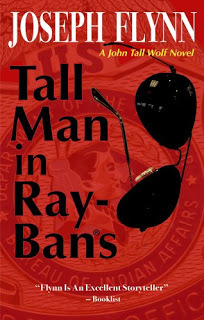 This book came out of left field. It’s the first of four John Tall Wolf novels. Author Flynn has a lot of titles to his credit. He has been published traditionally, but now appears to be doing well self-publishing under his own Stray Dog Press imprint…Halfway through The Tall Man In the Ray-Bans, I was enjoying it enough to swing over and pick up the three other titles in the series. Out for a day’s adventure exploring the dry bed of Lake Travis in Austin, Texas, two young boys stumble upon a skeleton. It might be all that remains of a fugitive named Randy Bear Heart. Wanted for robbing three banks and killing three cops, Bear Heart was never brought to justice. The FBI is called on to determine how the outlaw avoided arrest for twenty-five years and who put him in the lake wearing chains. The BIA — Bureau of Indian Affairs — gets the very same job. Special Agent John Tall Wolf is put on the case because one of the dead cops was a Native American who worked at the Mercy Ridge Reservation. The FBI wants John to “coordinate all your efforts” through SAC Gilbert Melvin. John is having none of that, saying, “I’ll conduct my investigation as I see fit.” He doesn’t even get along with his own boss, Marlene Flower Moon, head of the BIA’s Office of Justice Services. While interviewing John for his job, Marlene was amused by his assertiveness, and asked him, “What do you want, a license to take scalps?” John said, “Yeah, that’d be good.”
This book came out of left field. It’s the first of four John Tall Wolf novels. Author Flynn has a lot of titles to his credit. He has been published traditionally, but now appears to be doing well self-publishing under his own Stray Dog Press imprint…Halfway through The Tall Man In the Ray-Bans, I was enjoying it enough to swing over and pick up the three other titles in the series. Out for a day’s adventure exploring the dry bed of Lake Travis in Austin, Texas, two young boys stumble upon a skeleton. It might be all that remains of a fugitive named Randy Bear Heart. Wanted for robbing three banks and killing three cops, Bear Heart was never brought to justice. The FBI is called on to determine how the outlaw avoided arrest for twenty-five years and who put him in the lake wearing chains. The BIA — Bureau of Indian Affairs — gets the very same job. Special Agent John Tall Wolf is put on the case because one of the dead cops was a Native American who worked at the Mercy Ridge Reservation. The FBI wants John to “coordinate all your efforts” through SAC Gilbert Melvin. John is having none of that, saying, “I’ll conduct my investigation as I see fit.” He doesn’t even get along with his own boss, Marlene Flower Moon, head of the BIA’s Office of Justice Services. While interviewing John for his job, Marlene was amused by his assertiveness, and asked him, “What do you want, a license to take scalps?” John said, “Yeah, that’d be good.”
Published on September 30, 2016 13:23
September 7, 2016
WHAT’S IN A NAME ~ MCCURTIN, SLADE, GATLING, AND GARRITY
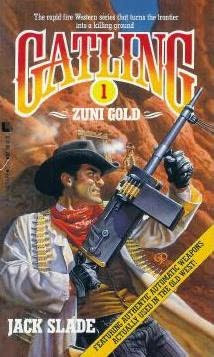 WHAT’S IN A NAME ~ MCCURTIN, SLADE, GATLING, AND GARRITY In 1968, Peter McCurtin sold two books to iconic sleaze paperback imprint Midwood, which was run by publisher Harry Shorten. Shorten later hired McCurtin to edit books for his other low end paperback houses, Tower, Belmont, and Leisure Books. While there, McCurtin not only edited manuscripts, but wrote books under his own name and a number of publishing house owned pseudonyms. He also turned his own byline into a house pseudonym, hiring other wordslingers to produce books as Peter McCurtin—all of which has created much confusion for collectors and completists. Paperback scholar Lynn Munroe has done an excellent job of researching McCurtin’s history and output, all of which can be found on his website:
CLICK HERE
WHAT’S IN A NAME ~ MCCURTIN, SLADE, GATLING, AND GARRITY In 1968, Peter McCurtin sold two books to iconic sleaze paperback imprint Midwood, which was run by publisher Harry Shorten. Shorten later hired McCurtin to edit books for his other low end paperback houses, Tower, Belmont, and Leisure Books. While there, McCurtin not only edited manuscripts, but wrote books under his own name and a number of publishing house owned pseudonyms. He also turned his own byline into a house pseudonym, hiring other wordslingers to produce books as Peter McCurtin—all of which has created much confusion for collectors and completists. Paperback scholar Lynn Munroe has done an excellent job of researching McCurtin’s history and output, all of which can be found on his website:
CLICK HERE
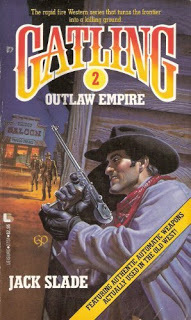 McCurtin first used the house name Jake Slade for the Lassiter series he created in 1969. He later used the Slade pseudonym for several entries in the Fargo and Sundance series—both created and originally written by revered western writer Ben Haas (under the pseudonym John Benteen) and edited by McCurtin. After Haas passed away, McCurtin took over the writing chores on the Sundance novels, publishing them under his own name. McCurtin wrote many of these books, but in some instances he provided plot ideas or half written novels to his crew of regular writers—the most prominent being George Harmon Smith—to complete. While the pseudonym Jack Slade originally hid the identity many different writers, McCurtin resurrected the name for his Gatling series. These are books he wrote late in his career with the help of his second wife, Mary Carr—who had previously worked with him on several entries in the Buckskinseries as Kit Dalton.
McCurtin first used the house name Jake Slade for the Lassiter series he created in 1969. He later used the Slade pseudonym for several entries in the Fargo and Sundance series—both created and originally written by revered western writer Ben Haas (under the pseudonym John Benteen) and edited by McCurtin. After Haas passed away, McCurtin took over the writing chores on the Sundance novels, publishing them under his own name. McCurtin wrote many of these books, but in some instances he provided plot ideas or half written novels to his crew of regular writers—the most prominent being George Harmon Smith—to complete. While the pseudonym Jack Slade originally hid the identity many different writers, McCurtin resurrected the name for his Gatling series. These are books he wrote late in his career with the help of his second wife, Mary Carr—who had previously worked with him on several entries in the Buckskinseries as Kit Dalton.
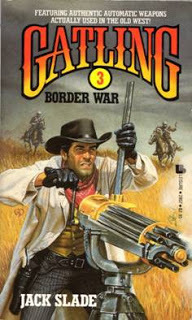 After extensive research, paperback historian Lynn Munroe has established that when Leisure Books killed the Gatling series after six books, McCurtin had already written the manuscripts for books seven and eight. Per Munroe, after a suitable waiting period, McCurtin changed Gatlin’s name to Garrity, repurposed the stories by shifting the emphasis away from the weaponry to feature the protagonist as a traditional hired gun, and sold the manuscripts as a new series—the prose style and plotting, however, clearly marking the books as Gatling adventures.
After extensive research, paperback historian Lynn Munroe has established that when Leisure Books killed the Gatling series after six books, McCurtin had already written the manuscripts for books seven and eight. Per Munroe, after a suitable waiting period, McCurtin changed Gatlin’s name to Garrity, repurposed the stories by shifting the emphasis away from the weaponry to feature the protagonist as a traditional hired gun, and sold the manuscripts as a new series—the prose style and plotting, however, clearly marking the books as Gatling adventures.
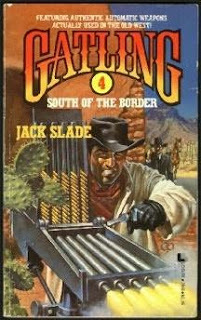 Personally, I was drawn to the Gatling series by the amazing covers featuring Gatling with different cutting edge weaponry from the western period. These covers are exceptionally rendered and several cuts above the slapdash efforts produced for the men’s adventure and western series of the time. Unfortunately, there is no attribution given to the cover artist on the copyright page of the books or elsewhere. The illustrator has signed the cover paintings with the stylized initials CP, but this does little to help establish identity at this late date.
Personally, I was drawn to the Gatling series by the amazing covers featuring Gatling with different cutting edge weaponry from the western period. These covers are exceptionally rendered and several cuts above the slapdash efforts produced for the men’s adventure and western series of the time. Unfortunately, there is no attribution given to the cover artist on the copyright page of the books or elsewhere. The illustrator has signed the cover paintings with the stylized initials CP, but this does little to help establish identity at this late date.
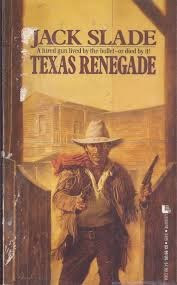
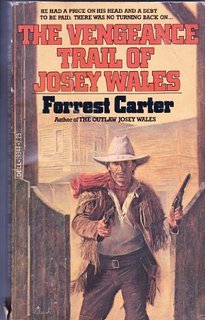 The covers used for the Garrity books (the repurposed Gatling manuscripts), however, are a completely different story. Research, again by Lynn Munroe, shows the cover art was for the two Garrity tales was copied, borrowed, or stolen from two Outlaw Josey Wales novels.
The covers used for the Garrity books (the repurposed Gatling manuscripts), however, are a completely different story. Research, again by Lynn Munroe, shows the cover art was for the two Garrity tales was copied, borrowed, or stolen from two Outlaw Josey Wales novels.
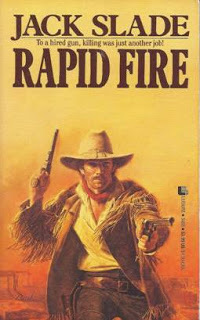
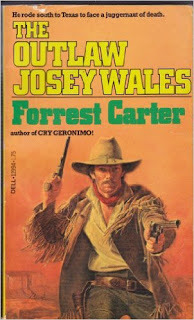 While the Gatling books are straight adventure novels in the tradition of the Fargo series, McCurtin indulges in some tongue-in-cheekness to explain how a man named Gatling works for the Maxim Gun Company—Maxim’s Col. Pritchett tells Gatling the only reason the Gatling Gun Company originally employed Gatlin was because they were afraid he might be the illegitimate offspring of their founder.
While the Gatling books are straight adventure novels in the tradition of the Fargo series, McCurtin indulges in some tongue-in-cheekness to explain how a man named Gatling works for the Maxim Gun Company—Maxim’s Col. Pritchett tells Gatling the only reason the Gatling Gun Company originally employed Gatlin was because they were afraid he might be the illegitimate offspring of their founder.
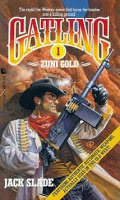 In his first adventure, Zuni Gold, Gatlin is sent to New Mexico—along with a Maxim light machinegun—to help the Zuni people, who are being slaughtered by Jicarilla Apaches working for the evil Copper Trust. An orphan, Gatling was raised by the Zuni and has an obvious motivation for accepting the challenge.
In his first adventure, Zuni Gold, Gatlin is sent to New Mexico—along with a Maxim light machinegun—to help the Zuni people, who are being slaughtered by Jicarilla Apaches working for the evil Copper Trust. An orphan, Gatling was raised by the Zuni and has an obvious motivation for accepting the challenge.
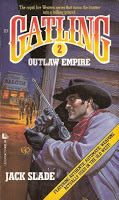 In Outlaw Empire, Gatlin takes on Wilson Murrill who, after 30 years in a Louisiana prison, is out to organize crime in the Western U.S. by enlisting the the Sydney Ducks (an Australian gang based in San Francisco), the Italian Black Hand in New Orleans, and every Irish thug and Mexican bandit in California.
In Outlaw Empire, Gatlin takes on Wilson Murrill who, after 30 years in a Louisiana prison, is out to organize crime in the Western U.S. by enlisting the the Sydney Ducks (an Australian gang based in San Francisco), the Italian Black Hand in New Orleans, and every Irish thug and Mexican bandit in California.
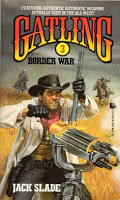 Next up, Gatling heads into a Border War delivering weapons to the metis people in their revolt against the Canadian government. Along te way Gatling meets the real-life figures Louis Riel and Gabriel Dumont. McCurtin was fascinated by the hisoriy of the revolt. He does give Border War a new story, but basis it on the same historic events he covered in Sundance: Day Of The Halfbreeds and Lassiter: Gunfight At Ringo Junction.
Next up, Gatling heads into a Border War delivering weapons to the metis people in their revolt against the Canadian government. Along te way Gatling meets the real-life figures Louis Riel and Gabriel Dumont. McCurtin was fascinated by the hisoriy of the revolt. He does give Border War a new story, but basis it on the same historic events he covered in Sundance: Day Of The Halfbreeds and Lassiter: Gunfight At Ringo Junction.
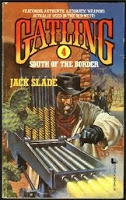 In Gatling’s fourth adventure, he is sent South Of The Border to Panama. Once there, he is forced to deal with rebel revolutionaries who intercept him while he escorts new automatic weapons to the American expedition building the Panama Canal.
In Gatling’s fourth adventure, he is sent South Of The Border to Panama. Once there, he is forced to deal with rebel revolutionaries who intercept him while he escorts new automatic weapons to the American expedition building the Panama Canal.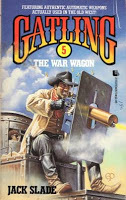 In book five, rebels have hijacked a shipment of rifles and ammunition in Mexico. Taking along TheWar Wagon—a deadly motorized monstrosity created by Maxim—Gatling is sent to get them back. In the final official Gatling book, Butte Bloodbath, Gatling ends up in the middle of a fight between Montana mine owners and Michael Patrick Kane, the fanatical Irish-born leader of the Western Labor League.
In book five, rebels have hijacked a shipment of rifles and ammunition in Mexico. Taking along TheWar Wagon—a deadly motorized monstrosity created by Maxim—Gatling is sent to get them back. In the final official Gatling book, Butte Bloodbath, Gatling ends up in the middle of a fight between Montana mine owners and Michael Patrick Kane, the fanatical Irish-born leader of the Western Labor League.
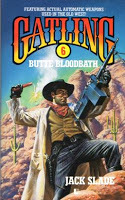 In 1993, Rapid Fire, the first of McCurtin’s repurposed Gatling manuscripts, has the rechristened Garrity reporting to Col. Pritchett of the Maxim Gun Company. In short order, Garrity is sent off to Brazil to retrieve weapons stolen by a hotheaded ex-Confederate General itching to go back to war. The final Gatling manuscript is repurposed as Texas Renegade, with Garrity in Texas to aid a Scottish cattle rancher being terrorized by the Ku Klux Klan and a group of labor thugs. As mentioned, I was first drawn to the Gatling series by the intriguing covers, but happily read my way through them enjoying McCurtin’s hard-bitten, straight forward, writing style at its best. These are well worth tracking down—but be forewarned, Gatling #6 Butte Bloodbath is fairly rare and pricey, but with patience a reasonable copy at a reasonable price can be found.
In 1993, Rapid Fire, the first of McCurtin’s repurposed Gatling manuscripts, has the rechristened Garrity reporting to Col. Pritchett of the Maxim Gun Company. In short order, Garrity is sent off to Brazil to retrieve weapons stolen by a hotheaded ex-Confederate General itching to go back to war. The final Gatling manuscript is repurposed as Texas Renegade, with Garrity in Texas to aid a Scottish cattle rancher being terrorized by the Ku Klux Klan and a group of labor thugs. As mentioned, I was first drawn to the Gatling series by the intriguing covers, but happily read my way through them enjoying McCurtin’s hard-bitten, straight forward, writing style at its best. These are well worth tracking down—but be forewarned, Gatling #6 Butte Bloodbath is fairly rare and pricey, but with patience a reasonable copy at a reasonable price can be found.
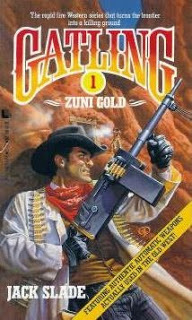



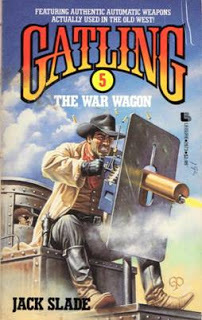
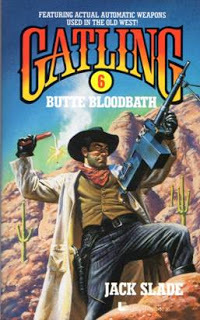 GATLIN SERIES Gatling #1: Zuni Gold (1989) Gatling #2: Outlaw Empire (1989) Gatling #3: Border War (1989) Gatling #4: South Of The Border (1989) Gatling #5: The War Wagon (1989) Gatling #6: Butte Bloodbath (1990)
GATLIN SERIES Gatling #1: Zuni Gold (1989) Gatling #2: Outlaw Empire (1989) Gatling #3: Border War (1989) Gatling #4: South Of The Border (1989) Gatling #5: The War Wagon (1989) Gatling #6: Butte Bloodbath (1990)
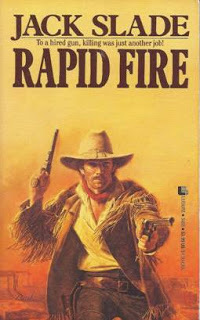
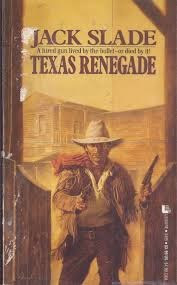 GARRITY (AKA: GATLIN) SERIES Rapid Fire (1993) Texas Renegade (1993)
GARRITY (AKA: GATLIN) SERIES Rapid Fire (1993) Texas Renegade (1993)
Published on September 07, 2016 12:56
August 17, 2016
THE GOOD, THE BAD, AND THE VERY BAD ~ PART THREE
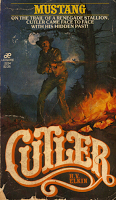
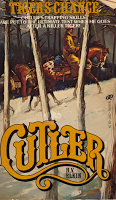
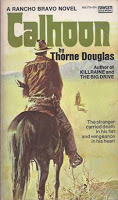 THE GOOD, THE BAD, AND THE VERY BAD ~ PART THREE Two of my recent columns have focused on the western men’s action adventure series Fargo and Sundance. Both were created and written by revered western writer Ben Haas under his John Benteen pseudonym. With the success of both series, publisher Harry Shorten asked Haas to create a third Benteen series—Cutler.
THE GOOD, THE BAD, AND THE VERY BAD ~ PART THREE Two of my recent columns have focused on the western men’s action adventure series Fargo and Sundance. Both were created and written by revered western writer Ben Haas under his John Benteen pseudonym. With the success of both series, publisher Harry Shorten asked Haas to create a third Benteen series—Cutler.
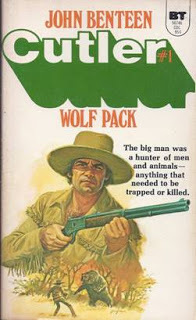 For various reasons, however, the lightning strikes of the Fargo and Sundance series never zapped Cutlerin the same way—possibly because Cutler was not a very nice character to be around. Both Fargo and Sundance are hard, violent men, but there is something honorable about them, which didn’t rub off on Cutler despite his righteous quest. Despite this lack of traction, the concept of a hardened hunter taking on rogue animals with a bounty on them is unusual enough to warrant reading.
For various reasons, however, the lightning strikes of the Fargo and Sundance series never zapped Cutlerin the same way—possibly because Cutler was not a very nice character to be around. Both Fargo and Sundance are hard, violent men, but there is something honorable about them, which didn’t rub off on Cutler despite his righteous quest. Despite this lack of traction, the concept of a hardened hunter taking on rogue animals with a bounty on them is unusual enough to warrant reading.
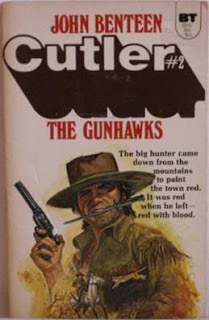 Physically, Cutler is a traditional Benteen hero—A taciturn, leathery, hunter of men and animals in his early thirties, John Cutler stands better than six feet tall, with broad, sloping shoulders, and a barrel-chest tapering to lean waist and slim hips. Shaggy raven’s wing black hair—faintly threaded with gray—spills from beneath a dusty, flat-crowned sombrero. His brows are great black marks above deep-set eyes the color of gunmetal, the planes of his big-nosed face rough and angular, his skin burnt to the color of rawhide by a life in the sun. His wardrobe consists of a filthy blue work shirt, a calfskin vest, jeans, fringed shotgun chaps, and flat-heeled boots made for walking as much as for riding. A holstered .44 Colt with a strap to hold it in its scabbard for rough riding swings from a cartridge belt around his waist, and on his other hip is a Case sheath knife.
Physically, Cutler is a traditional Benteen hero—A taciturn, leathery, hunter of men and animals in his early thirties, John Cutler stands better than six feet tall, with broad, sloping shoulders, and a barrel-chest tapering to lean waist and slim hips. Shaggy raven’s wing black hair—faintly threaded with gray—spills from beneath a dusty, flat-crowned sombrero. His brows are great black marks above deep-set eyes the color of gunmetal, the planes of his big-nosed face rough and angular, his skin burnt to the color of rawhide by a life in the sun. His wardrobe consists of a filthy blue work shirt, a calfskin vest, jeans, fringed shotgun chaps, and flat-heeled boots made for walking as much as for riding. A holstered .44 Colt with a strap to hold it in its scabbard for rough riding swings from a cartridge belt around his waist, and on his other hip is a Case sheath knife.
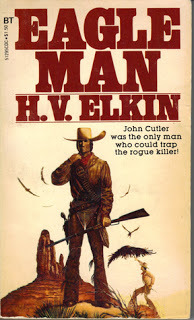 Cutler had been an experienced Federal Marshal in Indian Territory before retiring with his new bride to a ranch in Arizona. All was as he had imagined it until a rogue grizzly changes Cutler’s life forever. The bear—a huge monster with a silver blaze—had been killing cattle. Cutler sets traps to capture or kill the beast. When he returns to check them, however, he finds the rouge bear has escaped by chewing off the paw caught in the hunting traps vicious jaws.
Cutler had been an experienced Federal Marshal in Indian Territory before retiring with his new bride to a ranch in Arizona. All was as he had imagined it until a rogue grizzly changes Cutler’s life forever. The bear—a huge monster with a silver blaze—had been killing cattle. Cutler sets traps to capture or kill the beast. When he returns to check them, however, he finds the rouge bear has escaped by chewing off the paw caught in the hunting traps vicious jaws.
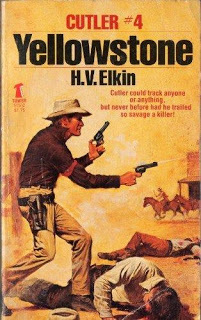 Cutler races home, but he is too late. Driven insane with pain, the giant animal has gone on a berserk rampage through Cutler’s ranch—where it savages Cutler’s pregnant wife. Cutler rides in just in time to catch her dying breath about the bear. Cutler immediately starts to hunt down the beast until a blizzard causes him to lose the trail. Five years pass. Cutler I now a nasty drunk who makes his living hunting and killing rogue animals with bounties on them—but the biggest rogue still eludes him. Unlike most bears, this monster stays on the move, killing anything in his path, with Cutler always a step behind…But Cutler will not give up.
Cutler races home, but he is too late. Driven insane with pain, the giant animal has gone on a berserk rampage through Cutler’s ranch—where it savages Cutler’s pregnant wife. Cutler rides in just in time to catch her dying breath about the bear. Cutler immediately starts to hunt down the beast until a blizzard causes him to lose the trail. Five years pass. Cutler I now a nasty drunk who makes his living hunting and killing rogue animals with bounties on them—but the biggest rogue still eludes him. Unlike most bears, this monster stays on the move, killing anything in his path, with Cutler always a step behind…But Cutler will not give up.
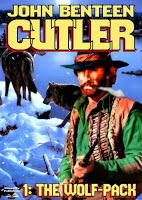
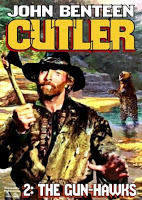
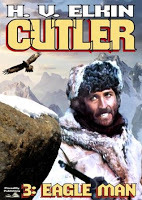
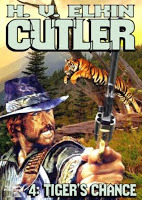
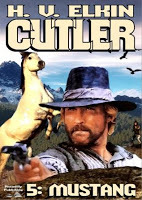
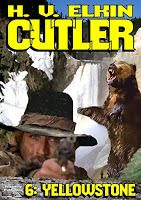 Haas/Benteen wrote the first two Cutler novels before dropping the series to concentrate on his far more popular Fargo and Sundance novels. The Cutler series was turned over to Vernon Hinkle—using the pseudonym H. V. Elkin—for four more titles before the series was shot down (possibly by rogue animal lovers or PETA)…
Haas/Benteen wrote the first two Cutler novels before dropping the series to concentrate on his far more popular Fargo and Sundance novels. The Cutler series was turned over to Vernon Hinkle—using the pseudonym H. V. Elkin—for four more titles before the series was shot down (possibly by rogue animal lovers or PETA)…

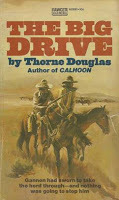
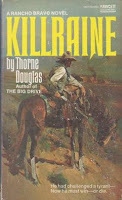 In a more positive vein, Haas had much more success with another western series, Rancho Bravo, written for Fawcett’s Gold Medal line under the name Thorne Douglas. Alternating points of view in each book, The Rancho Bravo series would have made a terrific ‘70s western TV series. The first four books in the series span a one year time frame after the end of the Civil War. Ex-Confederate rebel Lucius Calhoon, Texan trail boss Henry Gannon, Yankee officer Philip Killraine, and ex-slave Elias Whitton each tell their own story of coming together to build a Texas cattle empire.
In a more positive vein, Haas had much more success with another western series, Rancho Bravo, written for Fawcett’s Gold Medal line under the name Thorne Douglas. Alternating points of view in each book, The Rancho Bravo series would have made a terrific ‘70s western TV series. The first four books in the series span a one year time frame after the end of the Civil War. Ex-Confederate rebel Lucius Calhoon, Texan trail boss Henry Gannon, Yankee officer Philip Killraine, and ex-slave Elias Whitton each tell their own story of coming together to build a Texas cattle empire.
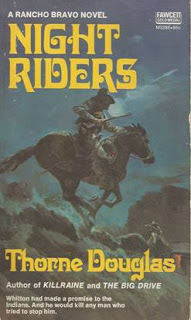 Calhoon is a bitter, one-handed, ex-plantation owner who has lost everything in the war. Gannon is a Texan trying to start a new ranch with wild cattle. Black cowboy, ex-slave, Elias Whitton is Gannon’s partner in the enterprise. When Killraine, quits his commission as a captain in the Northern Army to join them, Rancho Bravo is born.
Calhoon is a bitter, one-handed, ex-plantation owner who has lost everything in the war. Gannon is a Texan trying to start a new ranch with wild cattle. Black cowboy, ex-slave, Elias Whitton is Gannon’s partner in the enterprise. When Killraine, quits his commission as a captain in the Northern Army to join them, Rancho Bravo is born.
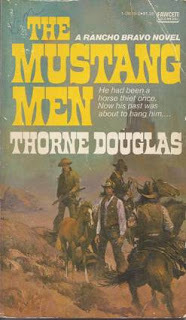 The Mustang Men, the fifth book in the series switches point of view again to tell the story of Shan Tyree, who comes to work at Rancho Bravo. Clearly, Haas had a vision of having visitors or employees of Rancho Bravo tell their own stories in each successive book. Unfortunately, Ben Haas died in 1977 (prior to book five being published) before he could expand Rancho Bravo stories further. While I’m still partial to the short, sharp, brutal Fargo tales, Ranch Bravo—in my opinion—is Haas’ crowning achievement. This series is not to be missed... THE RANCH BRAVO SERIES Calhoon (1972) The Big Drive (1973) Killraine (1975) Night Riders (1975) The Mustang Men (1977) FOR MORE ON RANCHO BRAVO CLICK HERE RANCHO BRAVO E-BOOKS FROM PICCADILLY PUBLISHING CLICK HERE THE CUTLER SERIES The Wolf-Pack (Benteen—1972) The Gunhawks (Benteen—1972)Eagle Man (H. V. Elkin—1978) Tiger’s Chance (H. V. Elkin—1980) Mustang (H. V. Elkin—1980) Yellowstone (H. V. Elkin—1980) FOR MORE ON CUTLER CLICK HERE CUTLER E-BOOKS FROM PICCADILLY PUBLISHING CLICK HERE
The Mustang Men, the fifth book in the series switches point of view again to tell the story of Shan Tyree, who comes to work at Rancho Bravo. Clearly, Haas had a vision of having visitors or employees of Rancho Bravo tell their own stories in each successive book. Unfortunately, Ben Haas died in 1977 (prior to book five being published) before he could expand Rancho Bravo stories further. While I’m still partial to the short, sharp, brutal Fargo tales, Ranch Bravo—in my opinion—is Haas’ crowning achievement. This series is not to be missed... THE RANCH BRAVO SERIES Calhoon (1972) The Big Drive (1973) Killraine (1975) Night Riders (1975) The Mustang Men (1977) FOR MORE ON RANCHO BRAVO CLICK HERE RANCHO BRAVO E-BOOKS FROM PICCADILLY PUBLISHING CLICK HERE THE CUTLER SERIES The Wolf-Pack (Benteen—1972) The Gunhawks (Benteen—1972)Eagle Man (H. V. Elkin—1978) Tiger’s Chance (H. V. Elkin—1980) Mustang (H. V. Elkin—1980) Yellowstone (H. V. Elkin—1980) FOR MORE ON CUTLER CLICK HERE CUTLER E-BOOKS FROM PICCADILLY PUBLISHING CLICK HERE
Published on August 17, 2016 15:37
August 16, 2016
THE GOOD, THE BAD, AND THE VERY BAD ~ PART TWO
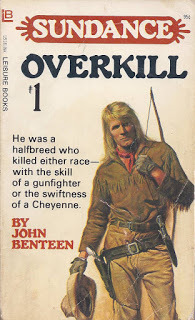
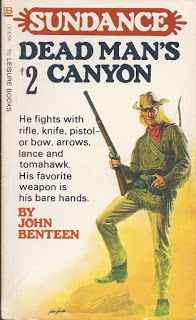 THE GOOD, THE BAD, AND THE VERY BAD ~ PART TWO
THE GOOD, THE BAD, AND THE VERY BAD ~ PART TWO
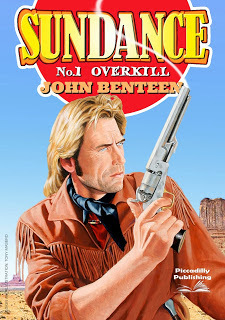 They called him Sundance. A big man with the bronzed face of a Cheyenne and a mane of yellow hair. He had ranged from Canada to Mexico, from the Mississippi to the Shining Mountains and west to the Pacific. He could take any man apart with rifle, pistol, knife—or Indian-style with bow, arrows, lance and tomahawk. He was a professional fighting man and no job was too tough if the price was right. So when a rich banker met his price of $10,000 to rescue his daughter from the Cheyenne—Sundance bought it. He didn’t know that before it was over he would have to take on a gang of vicious renegades, part of Custer’s Seventh Cavalry and a hot-blooded eastern woman...FROM SUNDANCE: OVERKILL
They called him Sundance. A big man with the bronzed face of a Cheyenne and a mane of yellow hair. He had ranged from Canada to Mexico, from the Mississippi to the Shining Mountains and west to the Pacific. He could take any man apart with rifle, pistol, knife—or Indian-style with bow, arrows, lance and tomahawk. He was a professional fighting man and no job was too tough if the price was right. So when a rich banker met his price of $10,000 to rescue his daughter from the Cheyenne—Sundance bought it. He didn’t know that before it was over he would have to take on a gang of vicious renegades, part of Custer’s Seventh Cavalry and a hot-blooded eastern woman...FROM SUNDANCE: OVERKILL
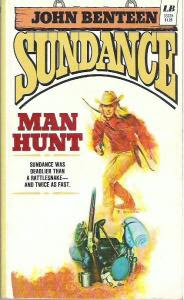 In the late ‘60s and early ‘70s under the pseudonym John Benteen, respected western author Ben Haas gunned out a series of paperback originals featuring the adventures of Fargo—a globetrotting soldier-of-fortune who is a dead ringer for Lee Marvin’s Faradan character in the 1966 movie The Professionals. The 23 Fargo novels remain below the radar of the wider readership, despite accolades from the gurus of the men’s action/adventure series genre.
In the late ‘60s and early ‘70s under the pseudonym John Benteen, respected western author Ben Haas gunned out a series of paperback originals featuring the adventures of Fargo—a globetrotting soldier-of-fortune who is a dead ringer for Lee Marvin’s Faradan character in the 1966 movie The Professionals. The 23 Fargo novels remain below the radar of the wider readership, despite accolades from the gurus of the men’s action/adventure series genre.
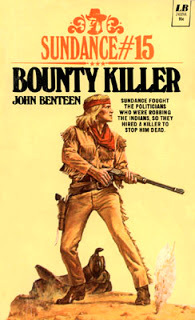 However, the Fargo series sold well enough for publisher
HARRY SHORTEN
(king of the low end mass market paperback houses in the ‘60s and ‘70s) to commission another western series from Haas under the John Benteen byline. Haas responded with the action filled adventures of the half-white, half-Cheyenne gun-for-hire known as Sundance. Writer and men’s action adventure series buff JACK BADELAIRE summarized the Sundance series for the current e-book releases from
PICCADILLY PUBLISHING
:
However, the Fargo series sold well enough for publisher
HARRY SHORTEN
(king of the low end mass market paperback houses in the ‘60s and ‘70s) to commission another western series from Haas under the John Benteen byline. Haas responded with the action filled adventures of the half-white, half-Cheyenne gun-for-hire known as Sundance. Writer and men’s action adventure series buff JACK BADELAIRE summarized the Sundance series for the current e-book releases from
PICCADILLY PUBLISHING
:
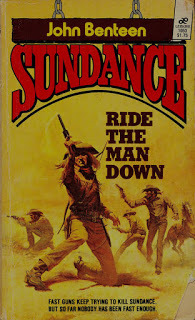 Jim Sundance, is a half-white, half-Cheyenne adventurer. In his 30's, he’s a man who has roamed and fought across the length and breadth of the U.S. moving between the worlds of the white man and the Indian. Sundance is a typical Benteen hero—Tall, broad-shouldered, with a slim waist and a lean, powerful build. He has the complexion and features of a Cheyenne Indian, but his hair is a bright golden blond, a gift from his English father. Sundance received his Indian name after participating in the Cheyenne Sun Dance ritual…
Jim Sundance, is a half-white, half-Cheyenne adventurer. In his 30's, he’s a man who has roamed and fought across the length and breadth of the U.S. moving between the worlds of the white man and the Indian. Sundance is a typical Benteen hero—Tall, broad-shouldered, with a slim waist and a lean, powerful build. He has the complexion and features of a Cheyenne Indian, but his hair is a bright golden blond, a gift from his English father. Sundance received his Indian name after participating in the Cheyenne Sun Dance ritual…
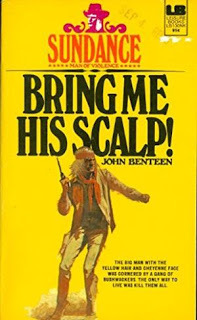 On top of his unusual heritage, Sundance carries an unusual arsenal. In typical Benteen fashion, his main character is very deliberately armed with an assortment of weapons from both cultures. Sundance carries a Navy Colt and a Henry repeating rifle, as well as a Bowie knife with a fourteen-inch blade and a hand guard for knife-fighting. In addition, he carries a steel-bladed tomahawk, as well as a Cheyenne dog soldier's war shield and a bow, along with a quiver of thirty flint-headed arrows. Benteen goes to great length to note Sundance prefers flint tips to steel, claiming they deliver a more grievous wound—Sundance can kill a man at four hundred yards with the bow, or put an arrow through a buffalo.
On top of his unusual heritage, Sundance carries an unusual arsenal. In typical Benteen fashion, his main character is very deliberately armed with an assortment of weapons from both cultures. Sundance carries a Navy Colt and a Henry repeating rifle, as well as a Bowie knife with a fourteen-inch blade and a hand guard for knife-fighting. In addition, he carries a steel-bladed tomahawk, as well as a Cheyenne dog soldier's war shield and a bow, along with a quiver of thirty flint-headed arrows. Benteen goes to great length to note Sundance prefers flint tips to steel, claiming they deliver a more grievous wound—Sundance can kill a man at four hundred yards with the bow, or put an arrow through a buffalo.
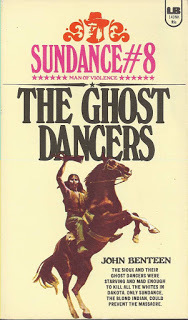 Over the course of the almost every novel, Sundance puts every weapon in his arsenal to use—another Benteen trait—and it is interesting to see how Sundance typically uses the white man's weapons for every day carry, but when he really means business, he tends to favor his more traditional arsenal. Sundance is a fascinating character, and the series is a mix of standard Western themes with Benteen's own unique style laid over. The action is fast and violent, the level of detail extraordinary...
Over the course of the almost every novel, Sundance puts every weapon in his arsenal to use—another Benteen trait—and it is interesting to see how Sundance typically uses the white man's weapons for every day carry, but when he really means business, he tends to favor his more traditional arsenal. Sundance is a fascinating character, and the series is a mix of standard Western themes with Benteen's own unique style laid over. The action is fast and violent, the level of detail extraordinary...
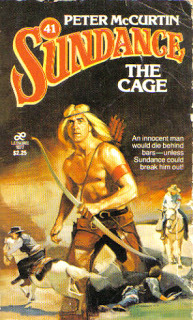 The Fargo and Sundance series were both extremely popular. To keep up with demand, several Sundance novels were published under the house name Jack Slade—For #11 Norman Rubington, #12 and #13 Thomas Curry, and #24 and #25 Dudley Dean McGaughy were the writers behind the Jack Slade pseudonym.
The Fargo and Sundance series were both extremely popular. To keep up with demand, several Sundance novels were published under the house name Jack Slade—For #11 Norman Rubington, #12 and #13 Thomas Curry, and #24 and #25 Dudley Dean McGaughy were the writers behind the Jack Slade pseudonym.When Haas passed away in 1977, Ballard wrote two more Sundance adventures in 1979, after which the series was taken over by long time editor Peter McCurtin for another eighteen novels. Haas/Benteen’s voice in the original Fargo and Sundance tales is golden. Entries from other wordslingers are hit and miss, so be aware your mileage may vary…
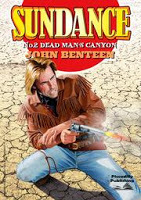
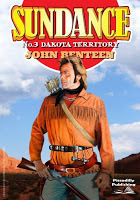
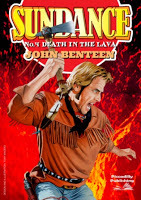
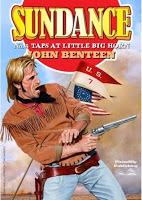
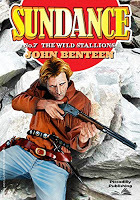
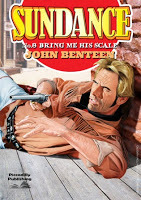
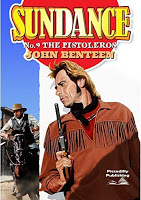
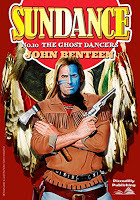
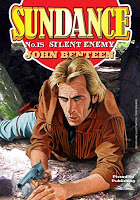
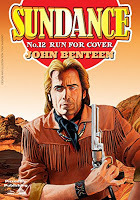 THE SUNDANCE SERIES Sundance #01: Overkill (John Benteen—1972)Sundance #02: Dead Man's Canyon (John Benteen—1972)Sundance #03: Dakota Territory (John Benteen—1972)Sundance #04: Death in the Lava (John Benteen—1972)Sundance #05: The Pistoleros (John Benteen—1972)Sundance #06: Wild Stallions (John Benteen—1973)Sundance #07: Taps at Little Big Horn (John Benteen—1973)Sundance #08: The Ghost Dancers (John Benteen—1973)Sundance #09: Bring Me His Scalp (John Benteen—1973)Sundance #10: The Bronco Trail (John Benteen—1973)Sundance #11: The Comancheros (Norman Rubington/Jack Slade—1973)
THE SUNDANCE SERIES Sundance #01: Overkill (John Benteen—1972)Sundance #02: Dead Man's Canyon (John Benteen—1972)Sundance #03: Dakota Territory (John Benteen—1972)Sundance #04: Death in the Lava (John Benteen—1972)Sundance #05: The Pistoleros (John Benteen—1972)Sundance #06: Wild Stallions (John Benteen—1973)Sundance #07: Taps at Little Big Horn (John Benteen—1973)Sundance #08: The Ghost Dancers (John Benteen—1973)Sundance #09: Bring Me His Scalp (John Benteen—1973)Sundance #10: The Bronco Trail (John Benteen—1973)Sundance #11: The Comancheros (Norman Rubington/Jack Slade—1973)Sundance #12: Renegade (Thomas Curry/Jack Slade—1974)Sundance #13: Honcho (Thomas Curry/Jack Slade—1974)Sundance #14: War Party (John Benteen—1975)Sundance #15: Bounty Killer (John Benteen—1975)Sundance #16: Run for Cover (John Benteen—1976)Sundance #17: Manhunt (John Benteen—1976)Sundance #18: Blood On the Prairie (John Benteen—1976)Sundance #19: War Trail (John Benteen—1976)Sundance #20: Riding Shotgun (John Benteen—1977)Sundance #21: Silent Enemy (John Benteen—1977)Sundance #22: Ride the Man Down (John Benteen—1973)Sundance #23: Gunbelt (John Benteen—1977)Sundance #24: Canyon Kill (Dudley Dean McGaughy/Jack Slade—1979)
Sundance #25: Blood Knife (Dudley Dean McGaughy/Jack Slade—1979)
Sundance #26: Nightriders (Peter McCurtin—1979)Sundance #27: Death Dance (Peter McCurtin—1979)Sundance #28: The Savage (Peter McCurtin—1979)Sundance #29: Day of the Halfbreeds (Peter McCurtin—1979)
Sundance #30: Los Olvidados (Peter McCurtin—1980)Sundance #31: The Marauders (Peter McCurtin—1980)Sundance #32: Scorpion (Peter McCurtin—1980)Sundance #33: Hangman's Knot (Peter McCurtin—1980)Sundance #34: Apache War (Peter McCurtin—1980)Sundance #35: Gold Strike (Peter McCurtin—1980)Sundance #36: Trail Drive (Peter McCurtin—1981)Sundance #37: Iron Men (Peter McCurtin—1981) Sundance #38: Drumfire (Peter McCurtin—1981) Sundance #39: Buffalo War (Peter McCurtin—1981)Sundance #40: The Hunters (Peter McCurtin—1981)Sundance #41: The Cage (Peter McCurtin—1981)Sundance #42: The Choctaw County War (Peter McCurtin—1982)
Sundance #43: Texas Empire (Peter McCurtin—1982)*It should be noted book seller and fiction scholar Lynn Munroe is the excellent source for the list of Sundance titles and authors behind the Jack Slade pseudonym. For Munroe's extensive rundown of Sundance titles CLICK HERE
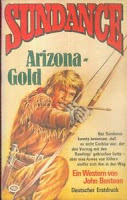
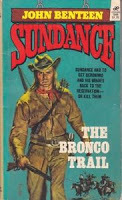
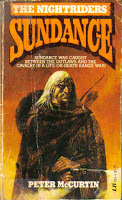
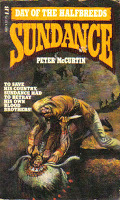
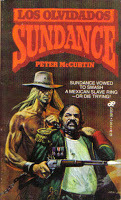
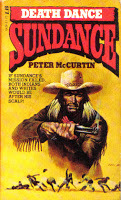
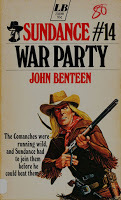
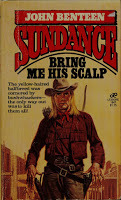
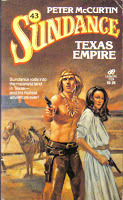
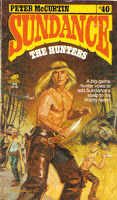
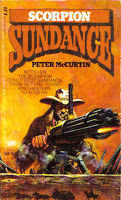
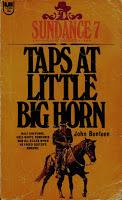
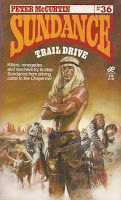
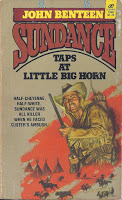
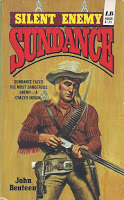
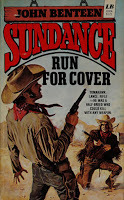
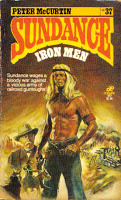
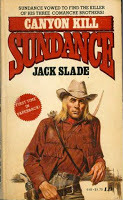 FOR MORE ON THE SUNDANCE E-BOOKS FROM PICCADILLY PUBLISHING CLICK HERE
FOR MORE ON THE SUNDANCE E-BOOKS FROM PICCADILLY PUBLISHING CLICK HERE
Published on August 16, 2016 18:00
August 14, 2016
THE GOOD, THE BAD, AND THE VERY BAD ~ PART ONE
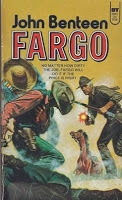
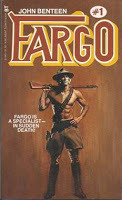
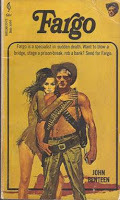 THE GOOD, THE BAD, AND THE VERY BAD ~ PART ONE Fargo lives with a gun in his fist. Guns and killing are all he knows. And Fargo likes what he knows. Want to start a revolution? Want to stop one? Send for Fargo. Want to blow a bridge, stage a prison break, rob a bank? Fargo’s your man.
THE GOOD, THE BAD, AND THE VERY BAD ~ PART ONE Fargo lives with a gun in his fist. Guns and killing are all he knows. And Fargo likes what he knows. Want to start a revolution? Want to stop one? Send for Fargo. Want to blow a bridge, stage a prison break, rob a bank? Fargo’s your man.
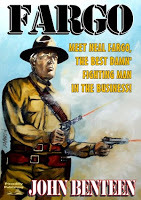 The Army taught Fargo how to kill with pistol, rifle, machine gun. He became an expert with knives, shotguns and women on his own time. Fargo hates the quiet life. He knows he’s going to get it sooner or later. He hopes it won’t be too much later because he wouldn’t know how to be old and comfortable. So while he lasts, Fargo plans to grab the world by the throat and take what he wants. If the world doesn’t like that, it can try to stop him ... if it can...DESCRIPTION FROM THE FIRST FARGO NOVEL Recently, I’ve blogged about a number of relatively obscure series from the men’s action adventure genre. Continuing the trend over the next couple of weeks, we saddle up for three iconic ‘60s western series written by John Benteen—the pseudonym of well-regarded and prolific writer Ben Haas.
The Army taught Fargo how to kill with pistol, rifle, machine gun. He became an expert with knives, shotguns and women on his own time. Fargo hates the quiet life. He knows he’s going to get it sooner or later. He hopes it won’t be too much later because he wouldn’t know how to be old and comfortable. So while he lasts, Fargo plans to grab the world by the throat and take what he wants. If the world doesn’t like that, it can try to stop him ... if it can...DESCRIPTION FROM THE FIRST FARGO NOVEL Recently, I’ve blogged about a number of relatively obscure series from the men’s action adventure genre. Continuing the trend over the next couple of weeks, we saddle up for three iconic ‘60s western series written by John Benteen—the pseudonym of well-regarded and prolific writer Ben Haas.
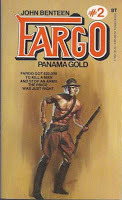 The main characters from all three series—Fargo, Sundance, and Cutler—have a devoted cult following among genre acolytes. The novels in each series stand apart from the other violence soaked westerns of the era, such as Edge, Crow, Claw (and countless others) written by the Piccadilly Cowboys (
CLICK HERE
). Neither do they fall into the arena of the popular adult sex-and-six-guns shoot-em-up western series like Longarm, Jake Slocum, or The Gunsmith (
CLICK HERE
). However, their combination of harsh, realistic ferocious action and adventurous backgrounds also set them apart from the more traditional Louis L’Amour style westerns.
The main characters from all three series—Fargo, Sundance, and Cutler—have a devoted cult following among genre acolytes. The novels in each series stand apart from the other violence soaked westerns of the era, such as Edge, Crow, Claw (and countless others) written by the Piccadilly Cowboys (
CLICK HERE
). Neither do they fall into the arena of the popular adult sex-and-six-guns shoot-em-up western series like Longarm, Jake Slocum, or The Gunsmith (
CLICK HERE
). However, their combination of harsh, realistic ferocious action and adventurous backgrounds also set them apart from the more traditional Louis L’Amour style westerns.
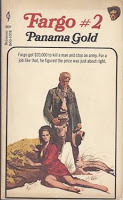 During the course of his career, Ben Haas wrote 130 novels under his own name, a dozen pseudonyms (including John Benteen), and a handful of publisher’s house names. The uniting factor of this vast output was the highly readable and sheer storytelling force he brought to every page. Haas’ goal was to be a mainstream writer, but needed to pay his bills while waiting for his serious fiction to find a publisher. Taking an opportunity to write a western for paperback publisher Tower Books, Haas furiously banged out Hell Of A Way To Die, quickly developing the spare, tightly written prose for which he became known. The novel became the fifth entry in Tower’s new Lassiter series (originated by wordslinger W.T. Ballard) published under the house name Jack Slade.
During the course of his career, Ben Haas wrote 130 novels under his own name, a dozen pseudonyms (including John Benteen), and a handful of publisher’s house names. The uniting factor of this vast output was the highly readable and sheer storytelling force he brought to every page. Haas’ goal was to be a mainstream writer, but needed to pay his bills while waiting for his serious fiction to find a publisher. Taking an opportunity to write a western for paperback publisher Tower Books, Haas furiously banged out Hell Of A Way To Die, quickly developing the spare, tightly written prose for which he became known. The novel became the fifth entry in Tower’s new Lassiter series (originated by wordslinger W.T. Ballard) published under the house name Jack Slade.
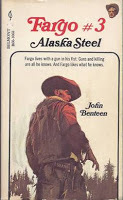 Impressed with Haas’ fast-paced muscular prose—a perfect fit for the burgeoning paperback original market—Tower publisher Harry Shorten asked Haas to create an original western series of his own. Recognizing a regular paying gig, Haas returned to assaulting his typewriter letting loose the taciturn, granite-hard, Neal Fargo in a series of neo-westerns now considered classics of the genre.
Impressed with Haas’ fast-paced muscular prose—a perfect fit for the burgeoning paperback original market—Tower publisher Harry Shorten asked Haas to create an original western series of his own. Recognizing a regular paying gig, Haas returned to assaulting his typewriter letting loose the taciturn, granite-hard, Neal Fargo in a series of neo-westerns now considered classics of the genre.
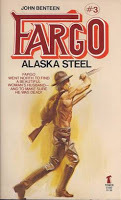 Under the pseudonym John Benteen—named after one of Custer’s cavalry officers—Haas wrote (or co-wrote with his son, Joel) twenty of the twenty three Fargo adventures. The other three books (Sierra Silver, Dynamite Fever, and Gringo Guns) are attributed to John W. Hardin—a pseudonym taken from a real life outlaw. According to fiction scholar
LYNN MUNROE
, John W. Hardin was most likely Norman Rubington, who also wrote an entry in Benteen’s Sundance series.
Under the pseudonym John Benteen—named after one of Custer’s cavalry officers—Haas wrote (or co-wrote with his son, Joel) twenty of the twenty three Fargo adventures. The other three books (Sierra Silver, Dynamite Fever, and Gringo Guns) are attributed to John W. Hardin—a pseudonym taken from a real life outlaw. According to fiction scholar
LYNN MUNROE
, John W. Hardin was most likely Norman Rubington, who also wrote an entry in Benteen’s Sundance series.
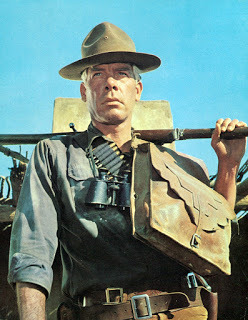 Common consensus is Haas based Fargo on the character portrayed by Lee Marvin in the 1966 movie The Professionals, which was written by Richard Brooks and based on the novel A Mule for the Marquesa by another popular western wordslinger, Frank O’Rourke. Brooks’ screenplay describes Marvin’s character, Faradan: He was one of Teddy Roosevelt’s Rough Riders, served in the Philippines, was a wildcatter and gold prospector, worked for Pancho Villa, and is now demonstrating automatic weapons to the Army. He is offered $10,000 for the dangerous assignment—all of which is a perfect description of Fargo. Marvin’s character also smokes black cigars and wears the campaign hat and cavalry boots, which are mainstays of Fargo’s wardrobe.
Common consensus is Haas based Fargo on the character portrayed by Lee Marvin in the 1966 movie The Professionals, which was written by Richard Brooks and based on the novel A Mule for the Marquesa by another popular western wordslinger, Frank O’Rourke. Brooks’ screenplay describes Marvin’s character, Faradan: He was one of Teddy Roosevelt’s Rough Riders, served in the Philippines, was a wildcatter and gold prospector, worked for Pancho Villa, and is now demonstrating automatic weapons to the Army. He is offered $10,000 for the dangerous assignment—all of which is a perfect description of Fargo. Marvin’s character also smokes black cigars and wears the campaign hat and cavalry boots, which are mainstays of Fargo’s wardrobe.
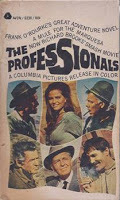 The image of Lee Marvin as Fargo has persisted ever since the books were first published. Piccadilly Publishing’s recent release of the Fargo novels in e-book format all carry a likeness of Lee Marvin as Fargo (as interpreted by artist Edward Martin) on the covers (
CLICK HERE
) along with this description:
The image of Lee Marvin as Fargo has persisted ever since the books were first published. Piccadilly Publishing’s recent release of the Fargo novels in e-book format all carry a likeness of Lee Marvin as Fargo (as interpreted by artist Edward Martin) on the covers (
CLICK HERE
) along with this description:
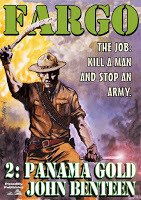 Neal Fargo—adventurer, lover and fighter—Fargo lives with a gun in his fist. Guns and killing are all he knows. And Fargo likes what he knows. Want to start a revolution? Want to stop one? Send for Fargo. Want to blow a bridge, stage a prison break, rob a bank? Fargo's your man...Tall and weather beaten, his prematurely white hair kept close-cropped, he still wears much the same outfit he wore in the service: cavalry boots, campaign hat, jodhpurs, or khaki pants, comfortable shirt...
Neal Fargo—adventurer, lover and fighter—Fargo lives with a gun in his fist. Guns and killing are all he knows. And Fargo likes what he knows. Want to start a revolution? Want to stop one? Send for Fargo. Want to blow a bridge, stage a prison break, rob a bank? Fargo's your man...Tall and weather beaten, his prematurely white hair kept close-cropped, he still wears much the same outfit he wore in the service: cavalry boots, campaign hat, jodhpurs, or khaki pants, comfortable shirt...
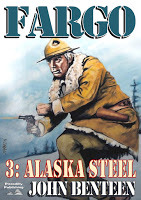 His weapons of war include a .38 with either a hip or shoulder holster, depending on his need at the time. Loading with hollow points for greater stopping power, he prefers it to the .45 automatic, which tends to jam, the army uses. His knife, a Batangas, made by Philippine artisans, has a razor sharp ten inch blade that folds back into the handle except for a few inches, popping out with a flick of the wrist. Fargo is quite expert with it and is ambidextrous, a little known fact hidden from his enemies, that has saved his life more than once in fights.
His weapons of war include a .38 with either a hip or shoulder holster, depending on his need at the time. Loading with hollow points for greater stopping power, he prefers it to the .45 automatic, which tends to jam, the army uses. His knife, a Batangas, made by Philippine artisans, has a razor sharp ten inch blade that folds back into the handle except for a few inches, popping out with a flick of the wrist. Fargo is quite expert with it and is ambidextrous, a little known fact hidden from his enemies, that has saved his life more than once in fights.
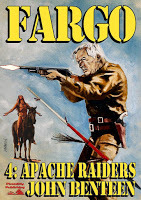 His favorite weapon, though, is the Fox Sterlingworth ten-gauge shotgun, sawed-off, and engraved along the inlay with the words, To Neal Fargo, gratefully, from T. Roosevelt. The former President and he are the only ones who know what he did to get the weapon. It's a deadly piece, loaded with shells of nine buckshot each. He's the only man Fargo will drop everything and come running when called...
His favorite weapon, though, is the Fox Sterlingworth ten-gauge shotgun, sawed-off, and engraved along the inlay with the words, To Neal Fargo, gratefully, from T. Roosevelt. The former President and he are the only ones who know what he did to get the weapon. It's a deadly piece, loaded with shells of nine buckshot each. He's the only man Fargo will drop everything and come running when called...
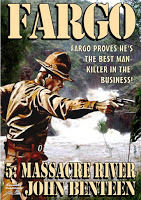 Writer and fictioneers extraordinaire
JAMES REASONER
rightly maintains the Fargo books are not really traditional Westerns as they are set in the 1910s, after the Wild West had been settled, and taking place in diverse locations such as the Philippines, Argentina, Nicaragua, Alaska and Peru. This distinction is part of the fun and what makes Fargo stand out among all his contemporaries.
Writer and fictioneers extraordinaire
JAMES REASONER
rightly maintains the Fargo books are not really traditional Westerns as they are set in the 1910s, after the Wild West had been settled, and taking place in diverse locations such as the Philippines, Argentina, Nicaragua, Alaska and Peru. This distinction is part of the fun and what makes Fargo stand out among all his contemporaries.
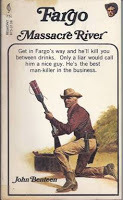
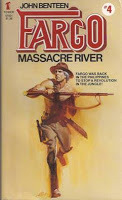
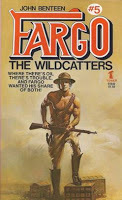
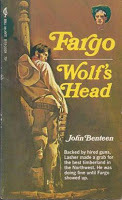
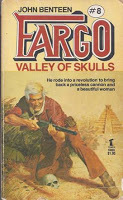
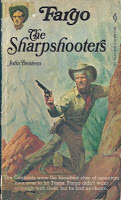
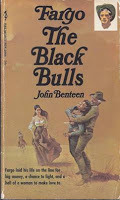
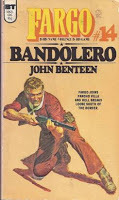
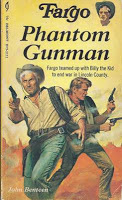
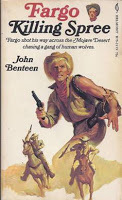
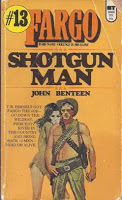
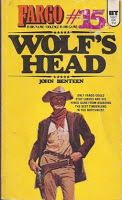
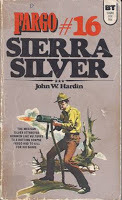
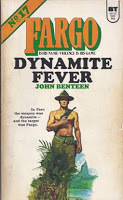
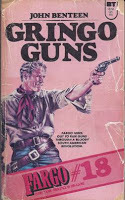
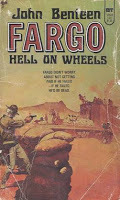
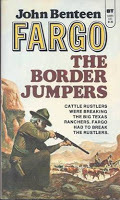
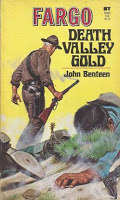
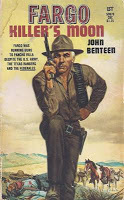
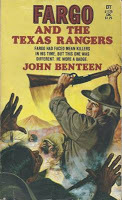
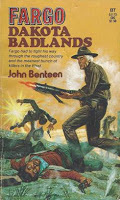 Prolific writer (
CLICK HERE
), blogger, and another true Fargo fan, JACK BADELAIRE, describes Fargo as a combination of giants from pop culture—To me, Neal Fargo is a combination of Robert E. Howard's Conan mixed with Sam Peckinpah's The Wild Bunch. Fargo, is a globe-trotting adventurer/mercenary in his late 30's, a highly-skilled and incredibly lethal fighting man who's already had a lifetime's worth of adventures. Like Conan, Fargo is a lone wolf, a man who trusts no one and nothing except, perhaps, his weapons. He fights for money and because it's what he's best at, and because he's one of the rare breed of men who, unashamedly, need to be in mortal conflict with man and the elements in order to feel alive. Fargo knows he'll meet a violent end one day, and you know his only hope is that he dies on his feet, surrounded by his enemies.
Prolific writer (
CLICK HERE
), blogger, and another true Fargo fan, JACK BADELAIRE, describes Fargo as a combination of giants from pop culture—To me, Neal Fargo is a combination of Robert E. Howard's Conan mixed with Sam Peckinpah's The Wild Bunch. Fargo, is a globe-trotting adventurer/mercenary in his late 30's, a highly-skilled and incredibly lethal fighting man who's already had a lifetime's worth of adventures. Like Conan, Fargo is a lone wolf, a man who trusts no one and nothing except, perhaps, his weapons. He fights for money and because it's what he's best at, and because he's one of the rare breed of men who, unashamedly, need to be in mortal conflict with man and the elements in order to feel alive. Fargo knows he'll meet a violent end one day, and you know his only hope is that he dies on his feet, surrounded by his enemies.
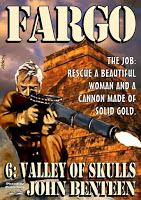
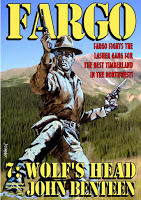
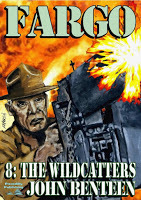
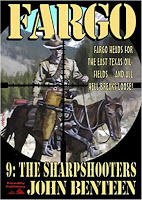
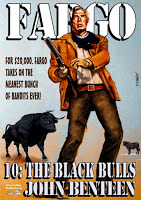
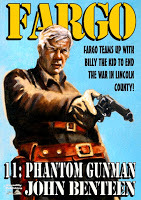
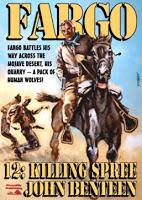
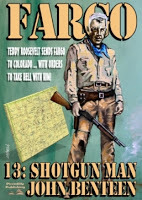
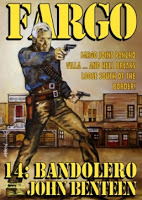 THE FARGO SERIES Fargo (1969)Panama Gold (1969)Alaska Steel (1969)Massacre River (1970)The Wildcatters (1970)Apache Raiders (1970)Valley of Skulls (1970)Wolf’s Head (1970)The Sharpshooters (1970)The Black Bulls (1971)Phantom Gunman (1971)Killing Spree (1971)Shotgun Man (1973)Bandolero (1973)Sierra Silver (John W. Hardin—1973)Dynamite Fever (John W. Hardin—1974)Gringo Guns (John W. Hardin—1975)Hell On Wheels (1976)The Border Jumpers (1976)Death Valley Gold (1976)Killer’s Moon (1976)Fargo and The Texas Rangers (1977)Dakota Badlands (1977) *Fargo #15 was originally assigned mistakenly to a reprint of #8 Wolf’s Head, which caused Belmont Tower to put #16 on what was actually the 15th book and triggering the misnumbering of the remaining books in the series. This accounts for the confusion regarding the total number of books—23 or 24—in the series…There are 23… FOR MORE ON THE INDIVIDUAL FARGO BOOKS FROM LYNN MUNROE CLICK HERE, AND HERE FOR BENTEEN/HAAS’ ADVICE ON HOW TO WRITE A WESTERN CLICK HERE FOR MORE ON THE FARGO SERIES CLICK HERE In Part Two next week, we’ll take on two other iconic western series from John Benteen—the popular Sundance—as mentioned above—and the unique, but less well received, Cutler…
THE FARGO SERIES Fargo (1969)Panama Gold (1969)Alaska Steel (1969)Massacre River (1970)The Wildcatters (1970)Apache Raiders (1970)Valley of Skulls (1970)Wolf’s Head (1970)The Sharpshooters (1970)The Black Bulls (1971)Phantom Gunman (1971)Killing Spree (1971)Shotgun Man (1973)Bandolero (1973)Sierra Silver (John W. Hardin—1973)Dynamite Fever (John W. Hardin—1974)Gringo Guns (John W. Hardin—1975)Hell On Wheels (1976)The Border Jumpers (1976)Death Valley Gold (1976)Killer’s Moon (1976)Fargo and The Texas Rangers (1977)Dakota Badlands (1977) *Fargo #15 was originally assigned mistakenly to a reprint of #8 Wolf’s Head, which caused Belmont Tower to put #16 on what was actually the 15th book and triggering the misnumbering of the remaining books in the series. This accounts for the confusion regarding the total number of books—23 or 24—in the series…There are 23… FOR MORE ON THE INDIVIDUAL FARGO BOOKS FROM LYNN MUNROE CLICK HERE, AND HERE FOR BENTEEN/HAAS’ ADVICE ON HOW TO WRITE A WESTERN CLICK HERE FOR MORE ON THE FARGO SERIES CLICK HERE In Part Two next week, we’ll take on two other iconic western series from John Benteen—the popular Sundance—as mentioned above—and the unique, but less well received, Cutler…
Published on August 14, 2016 16:07



